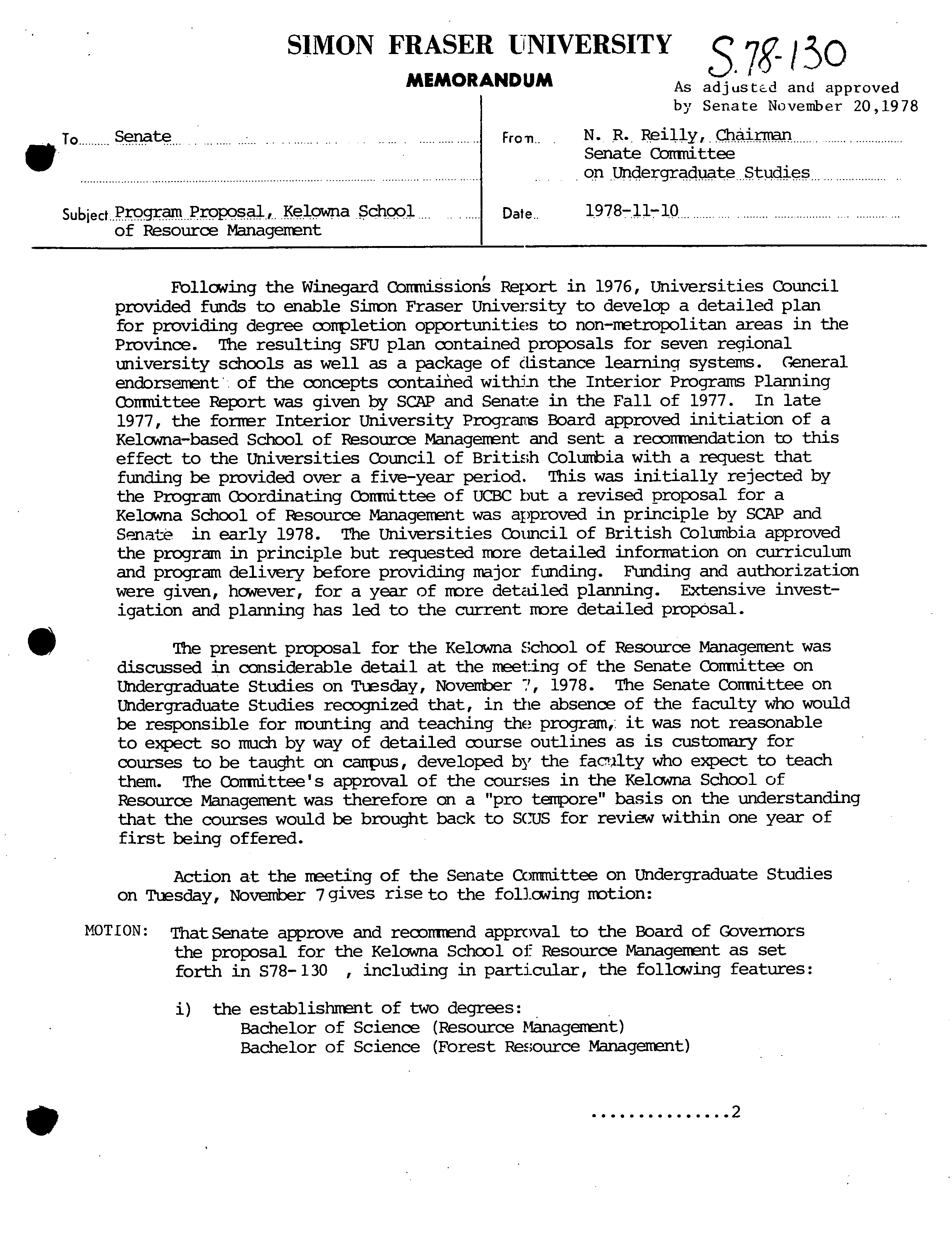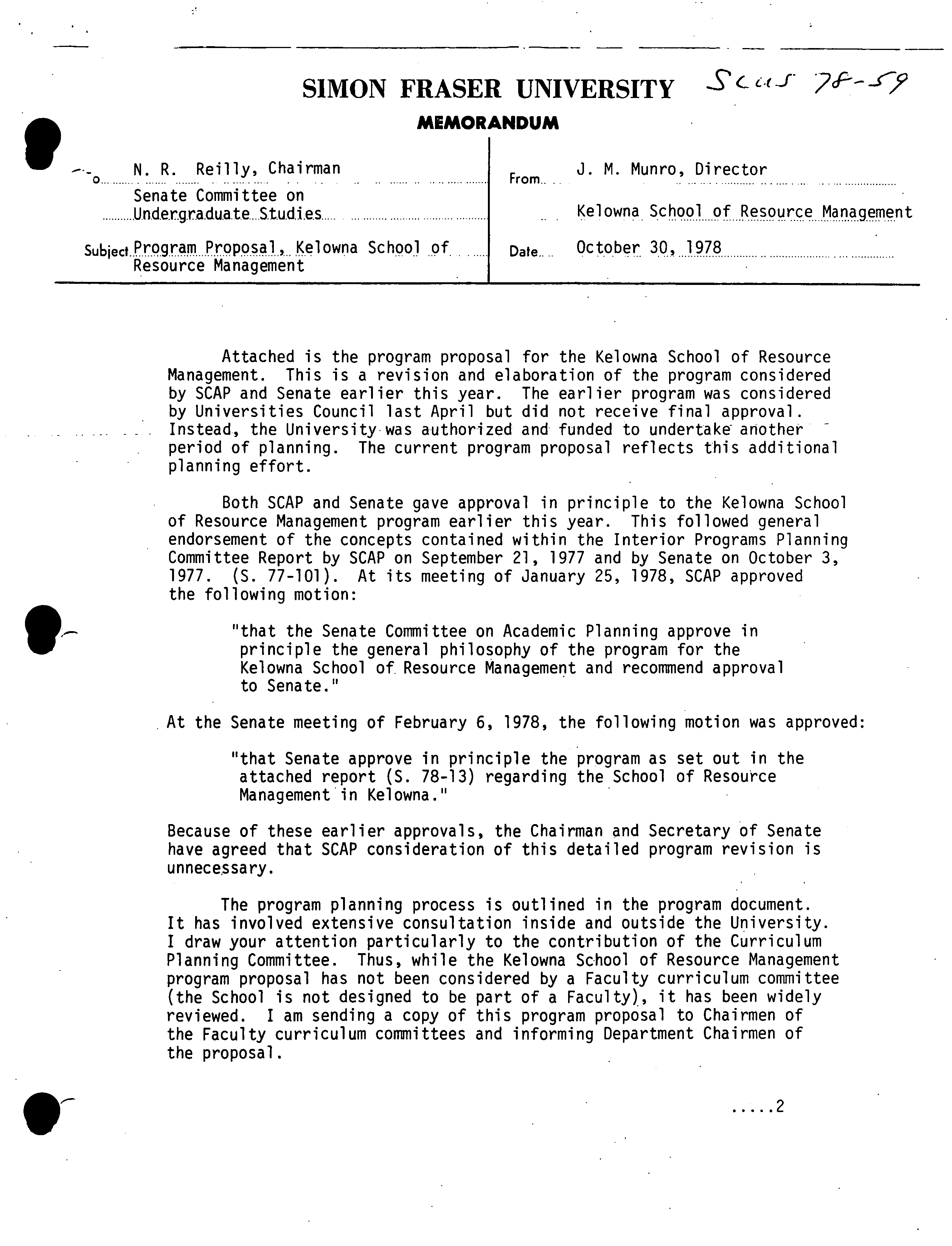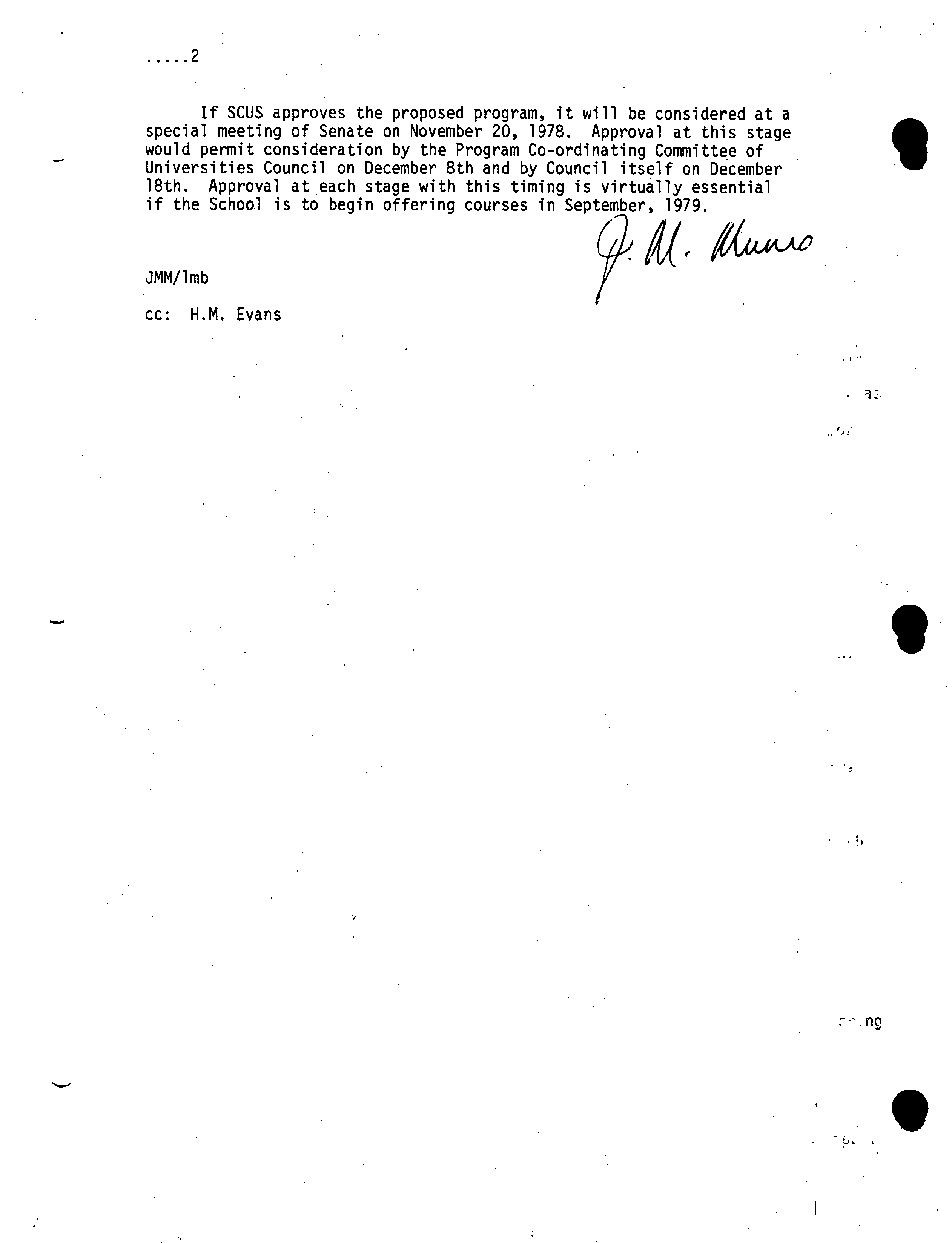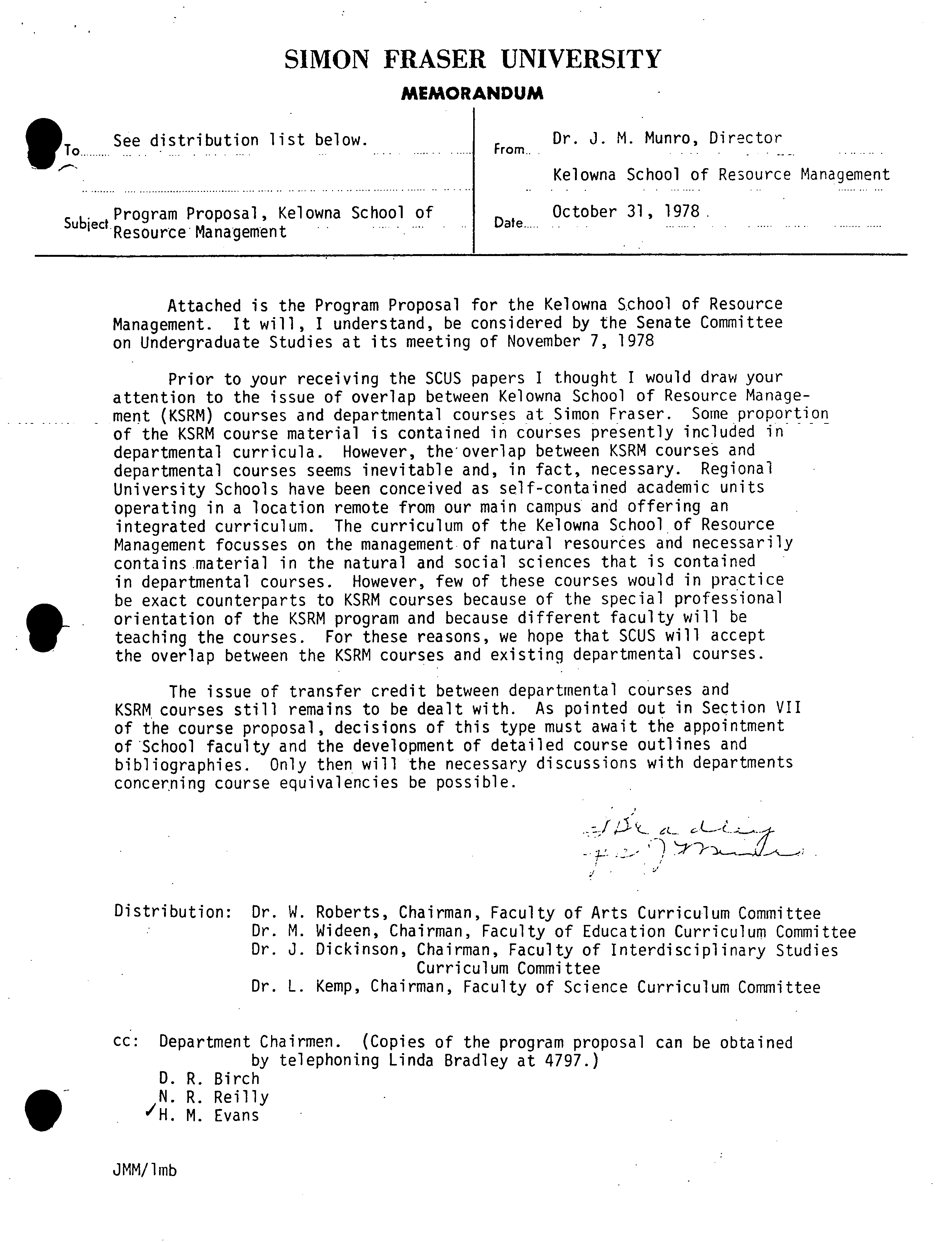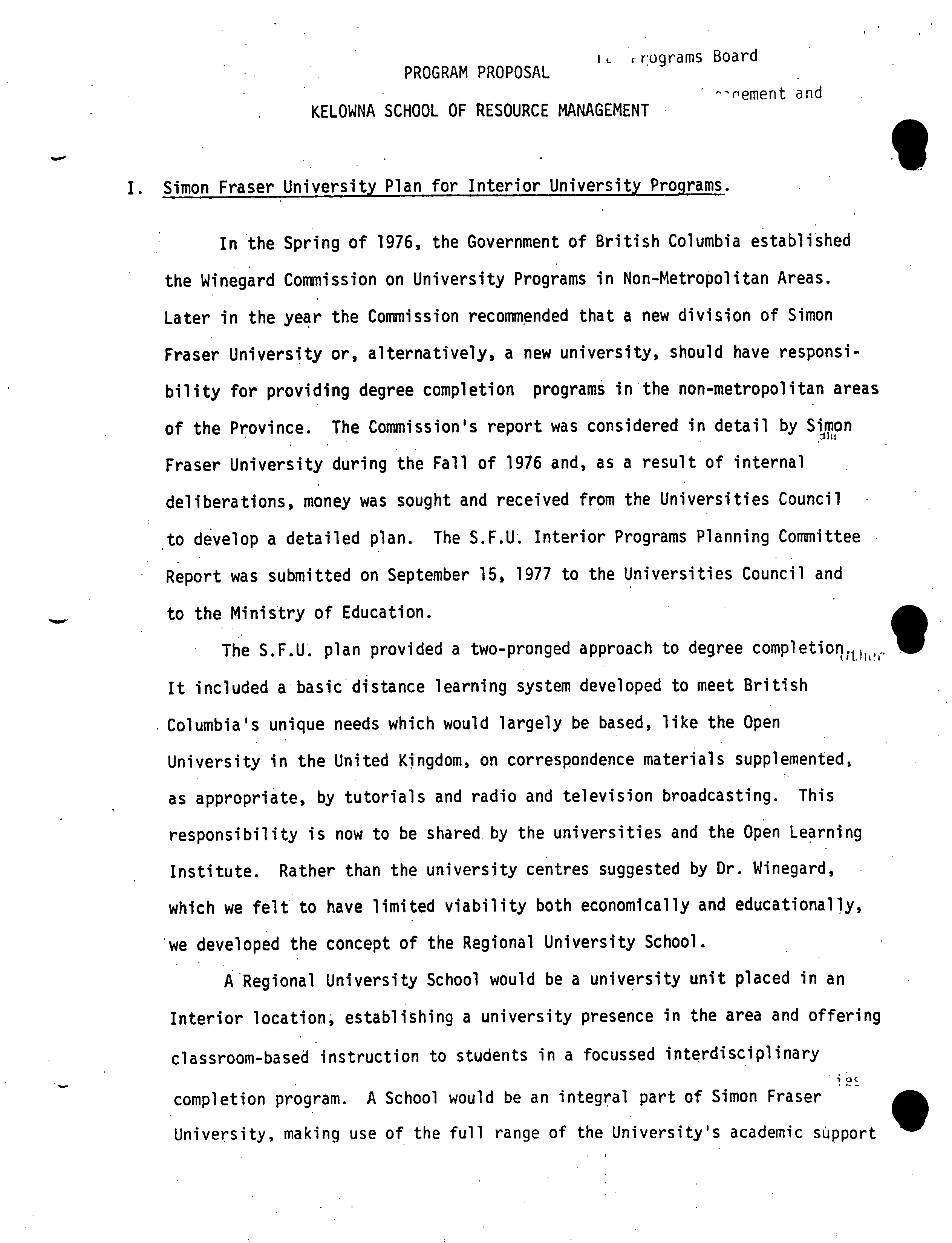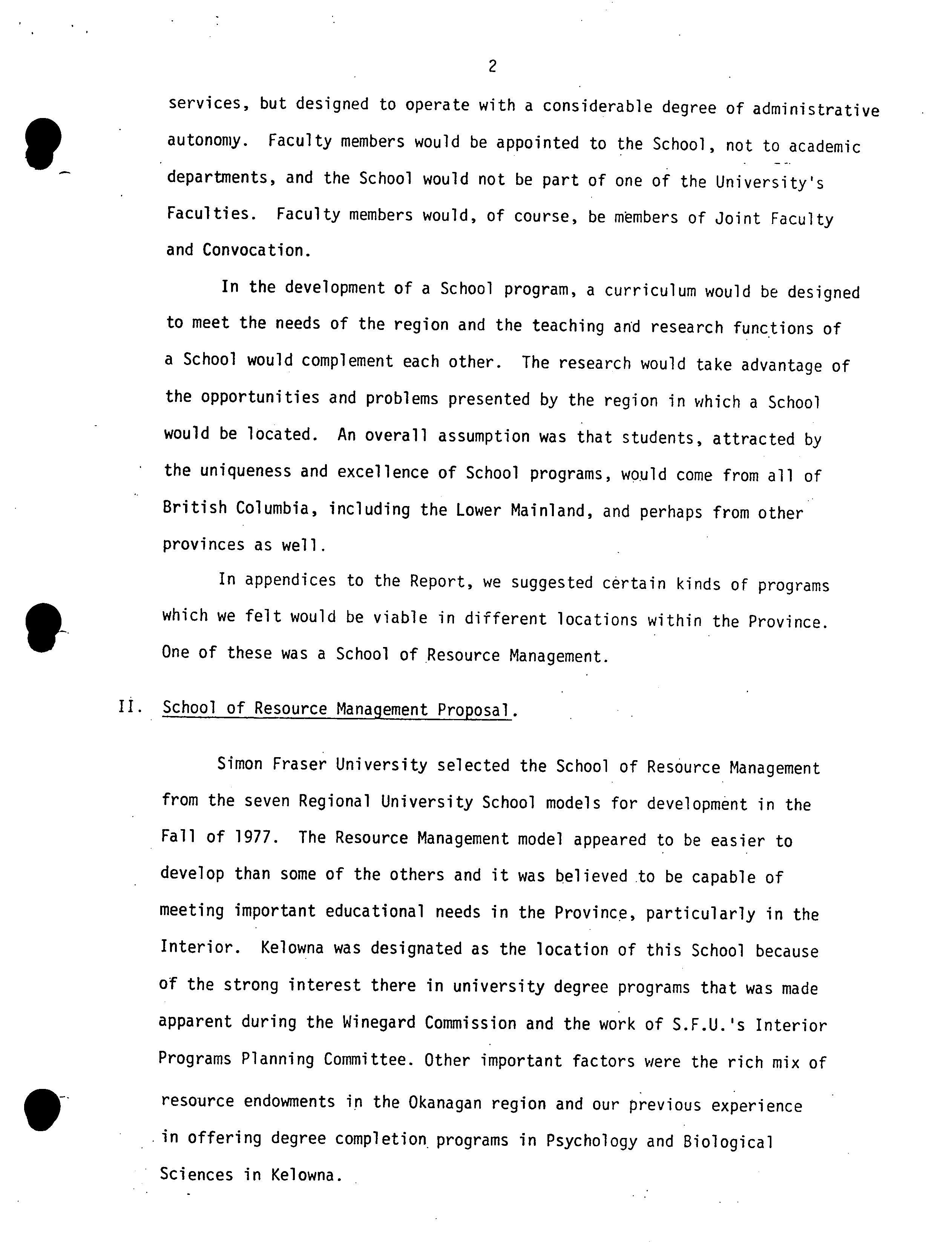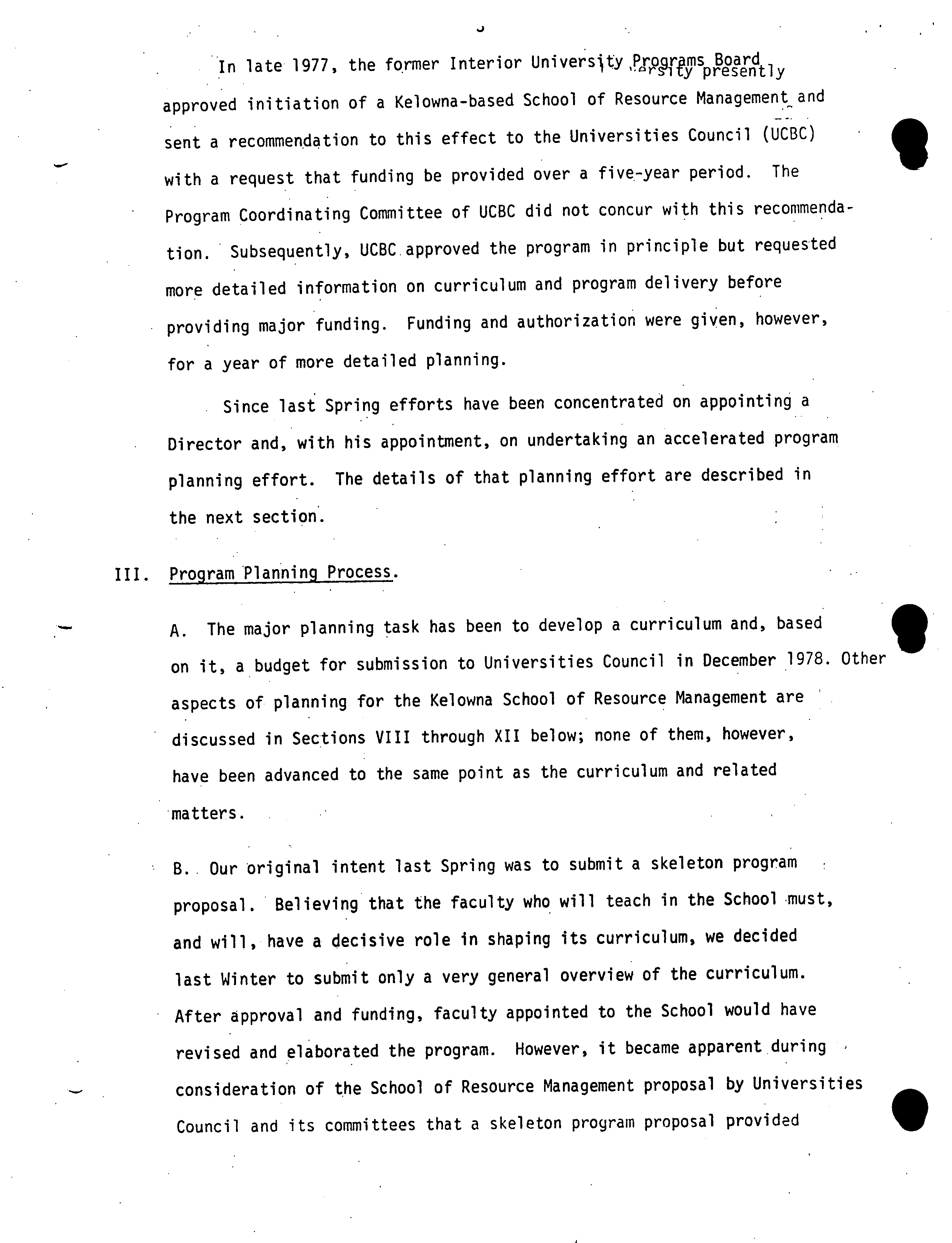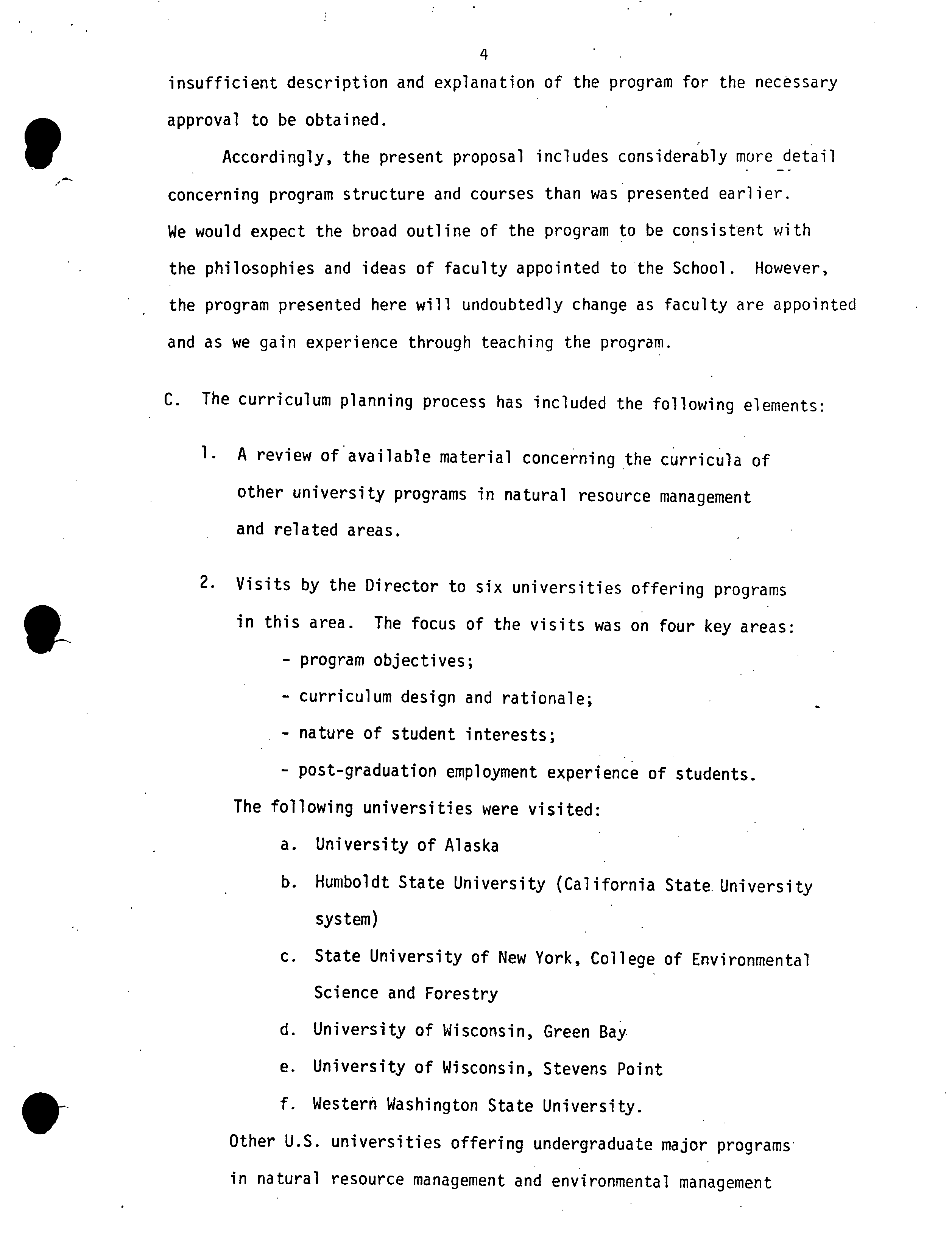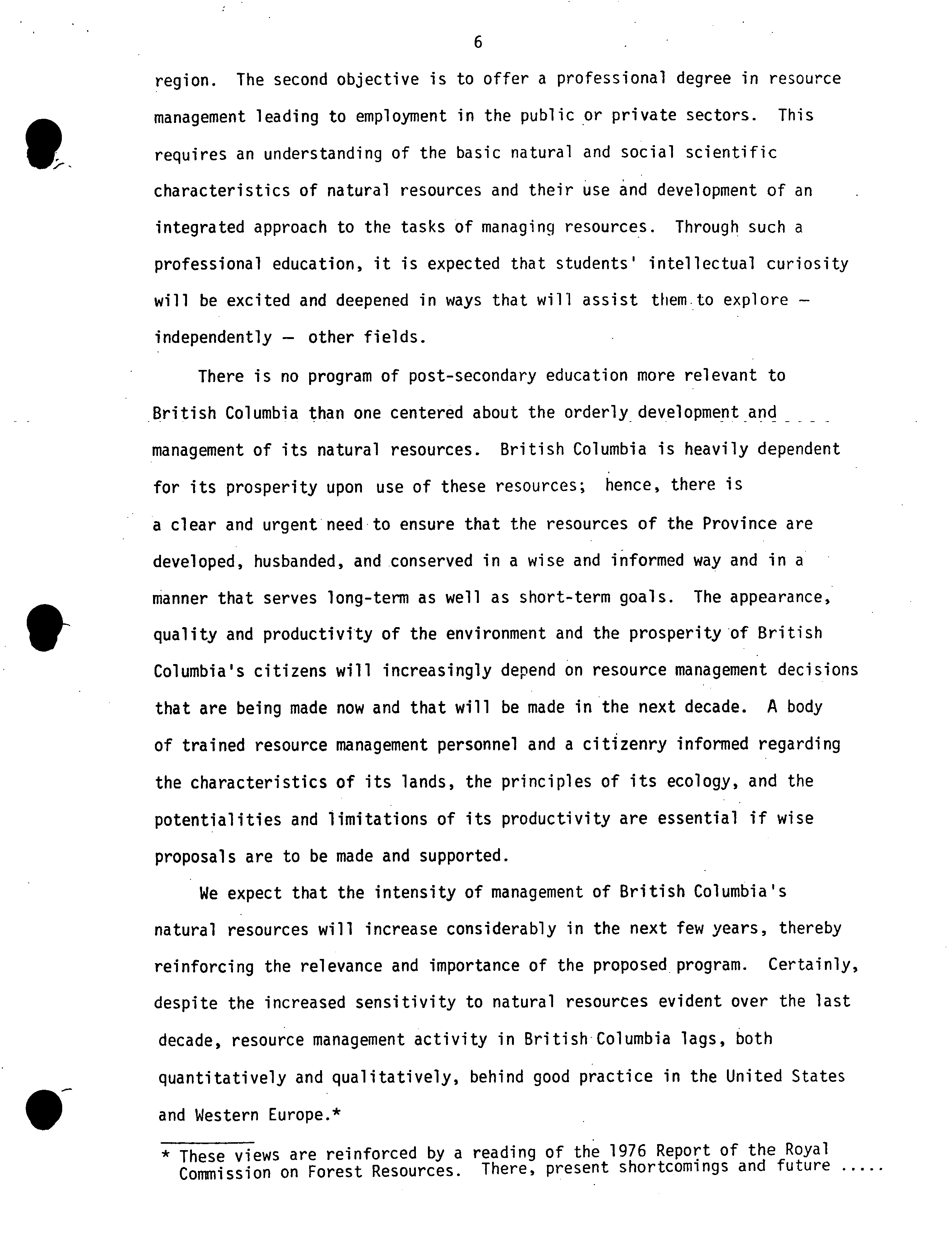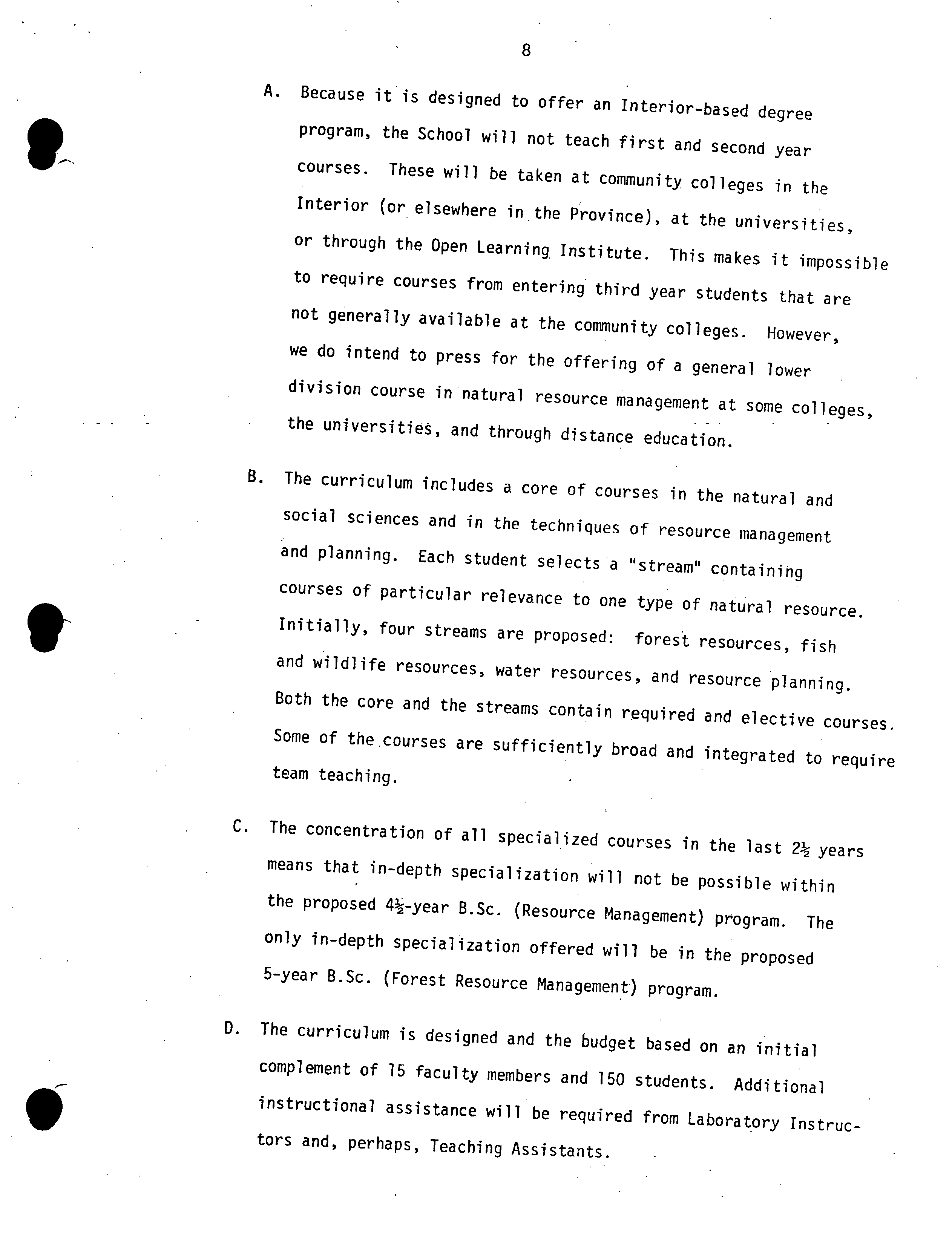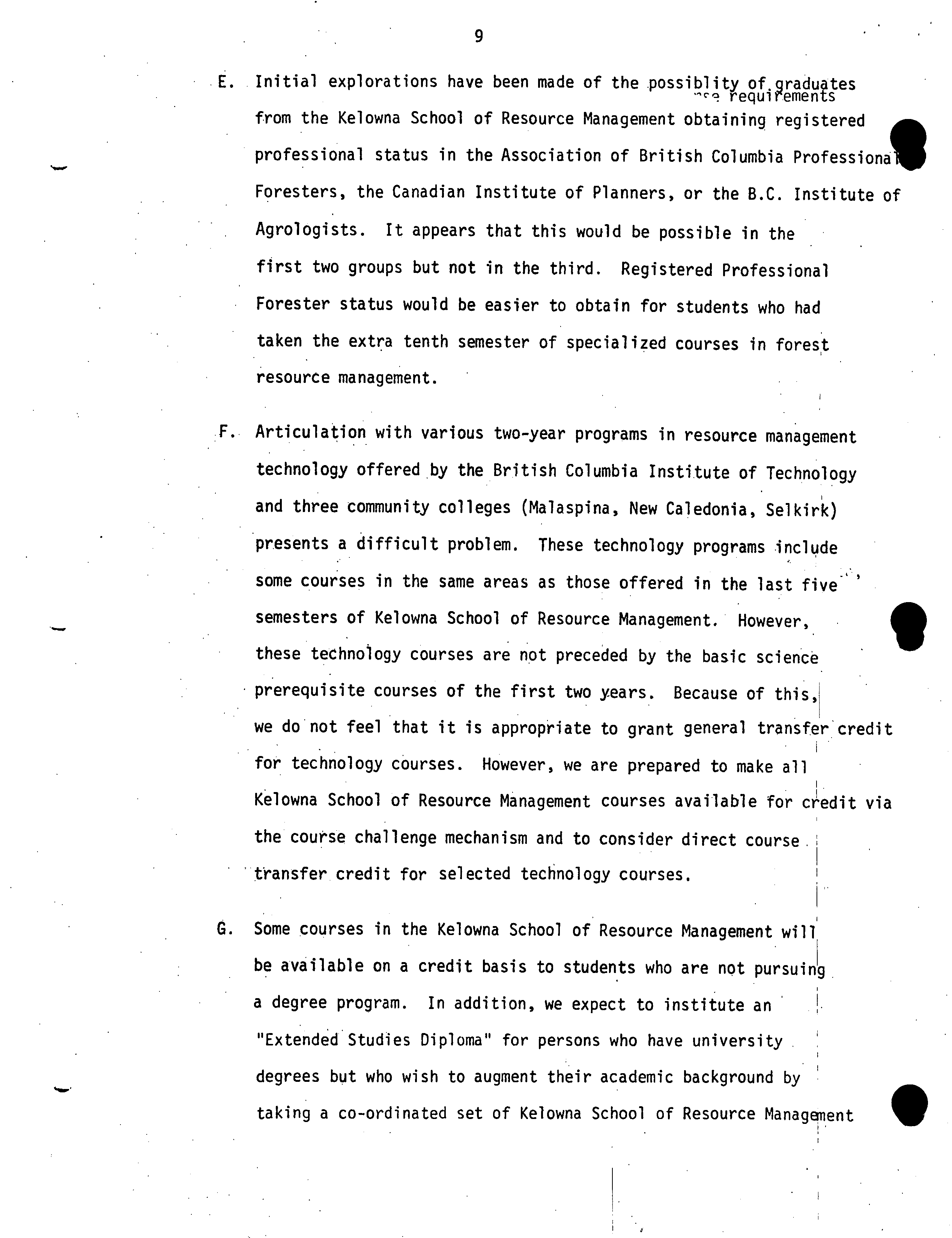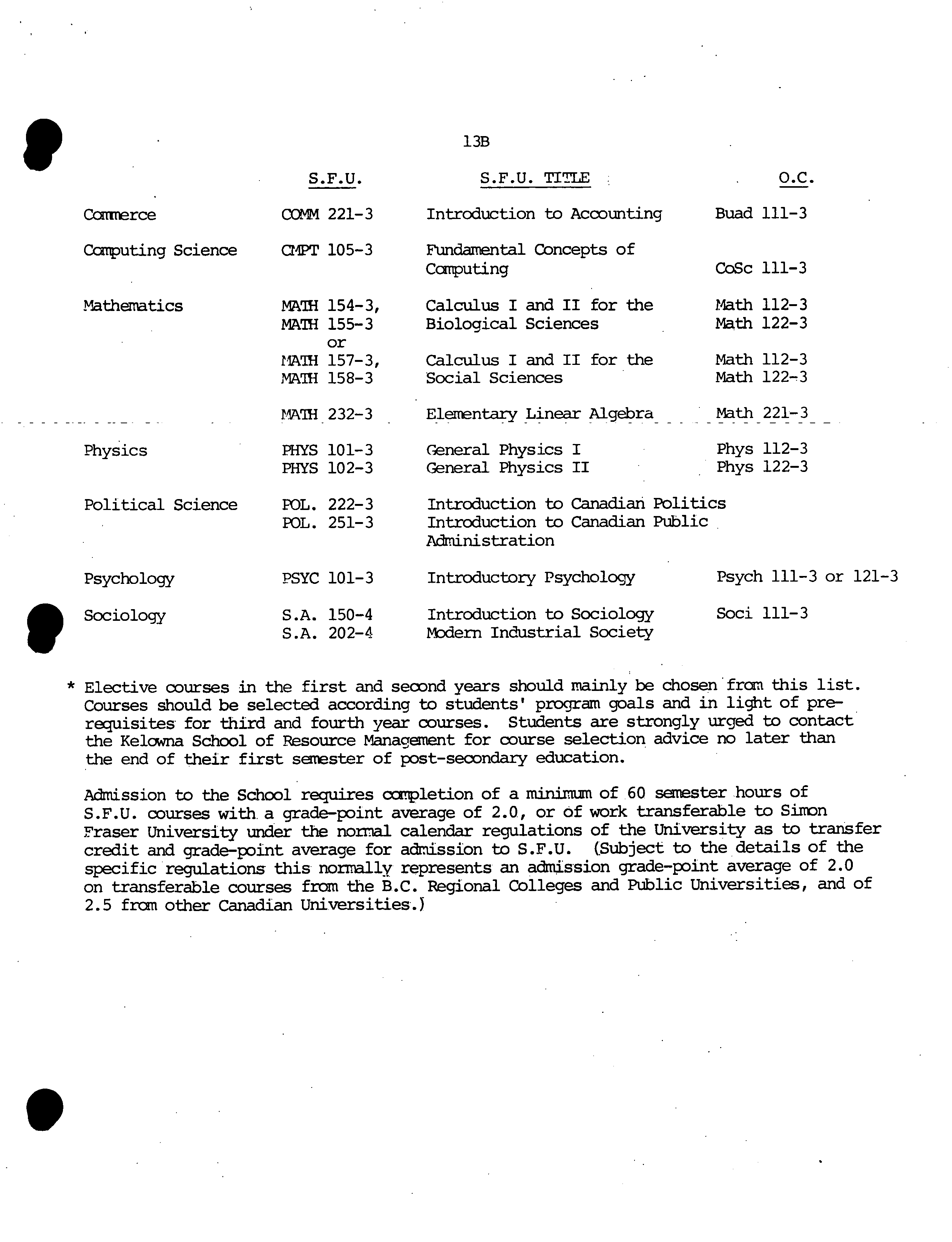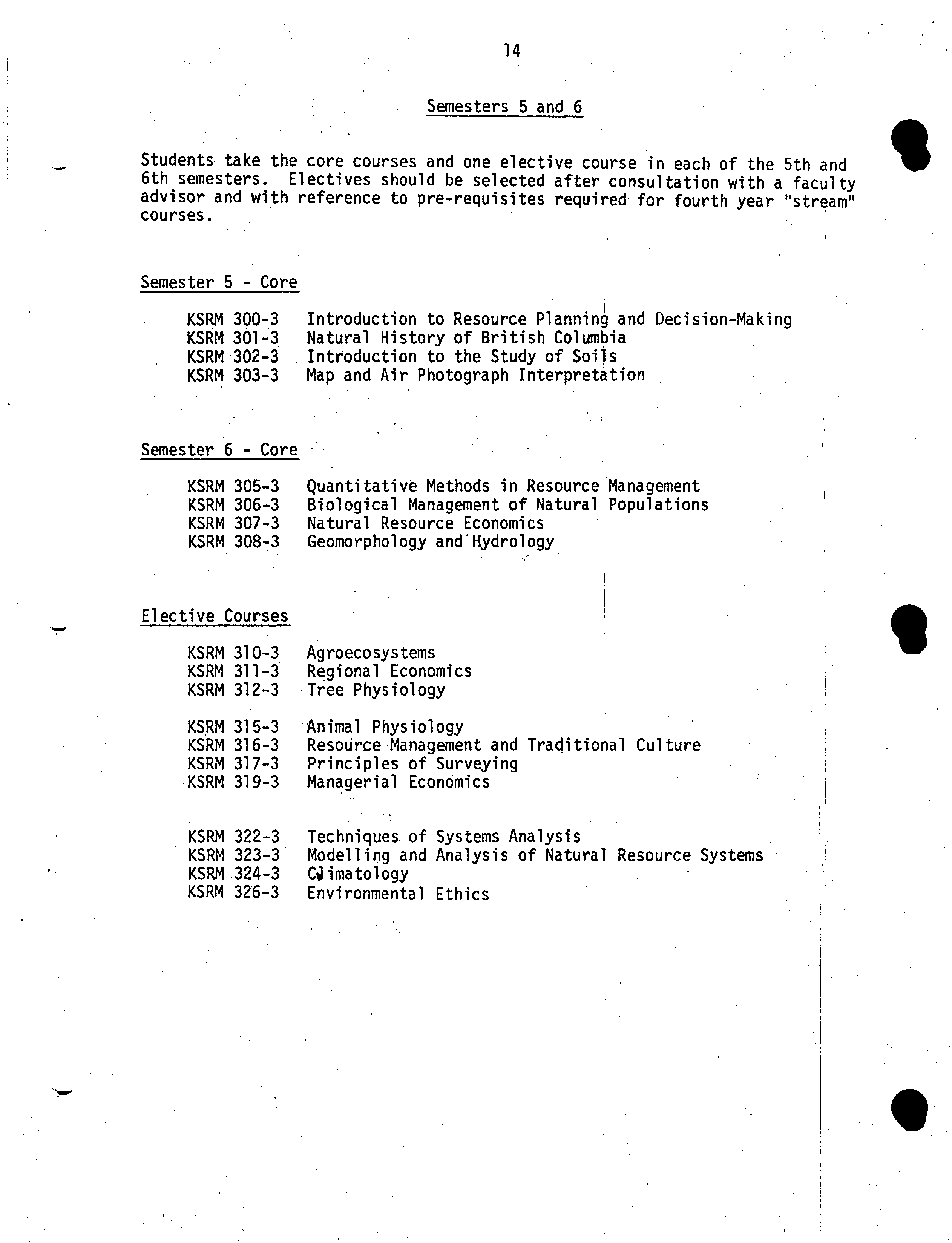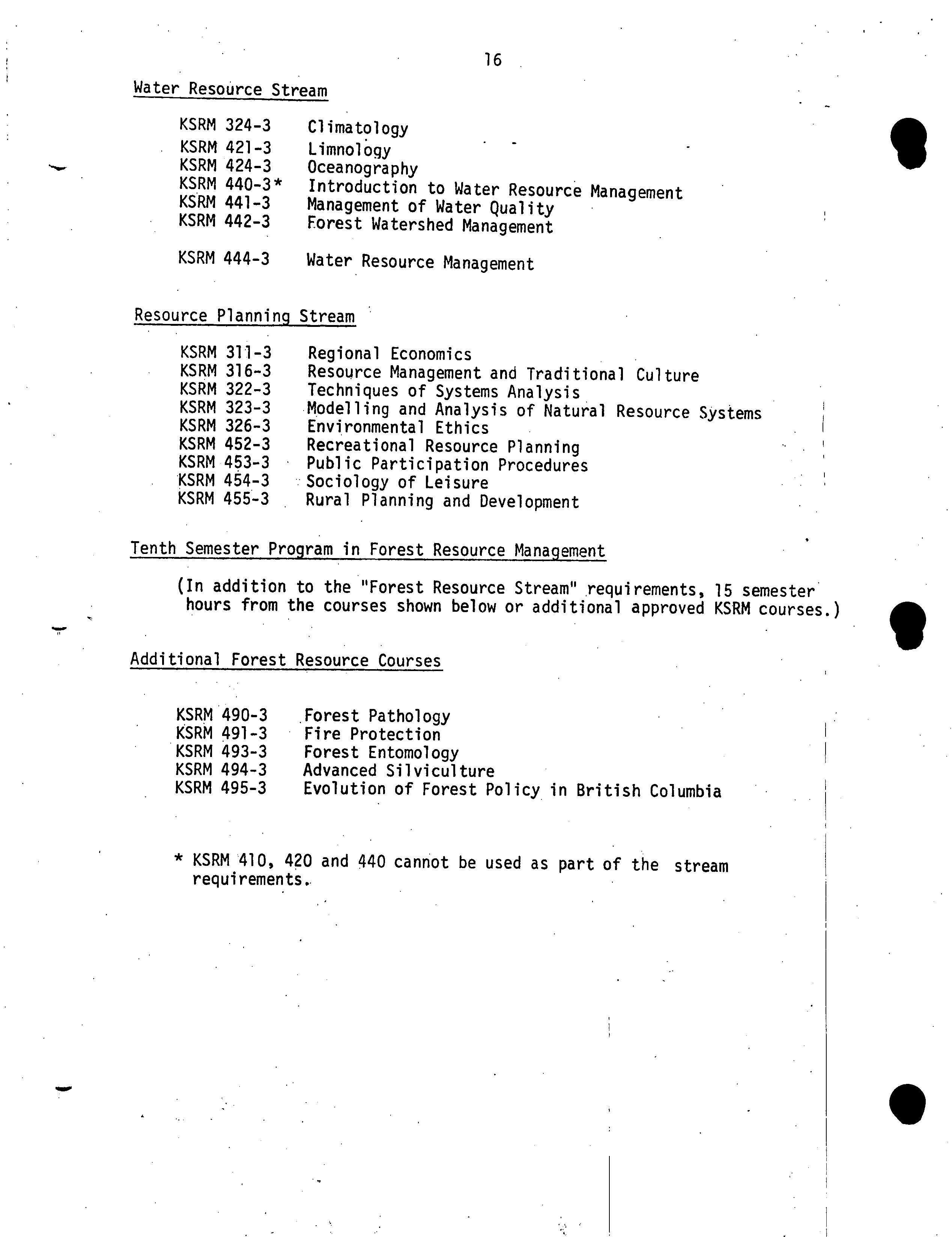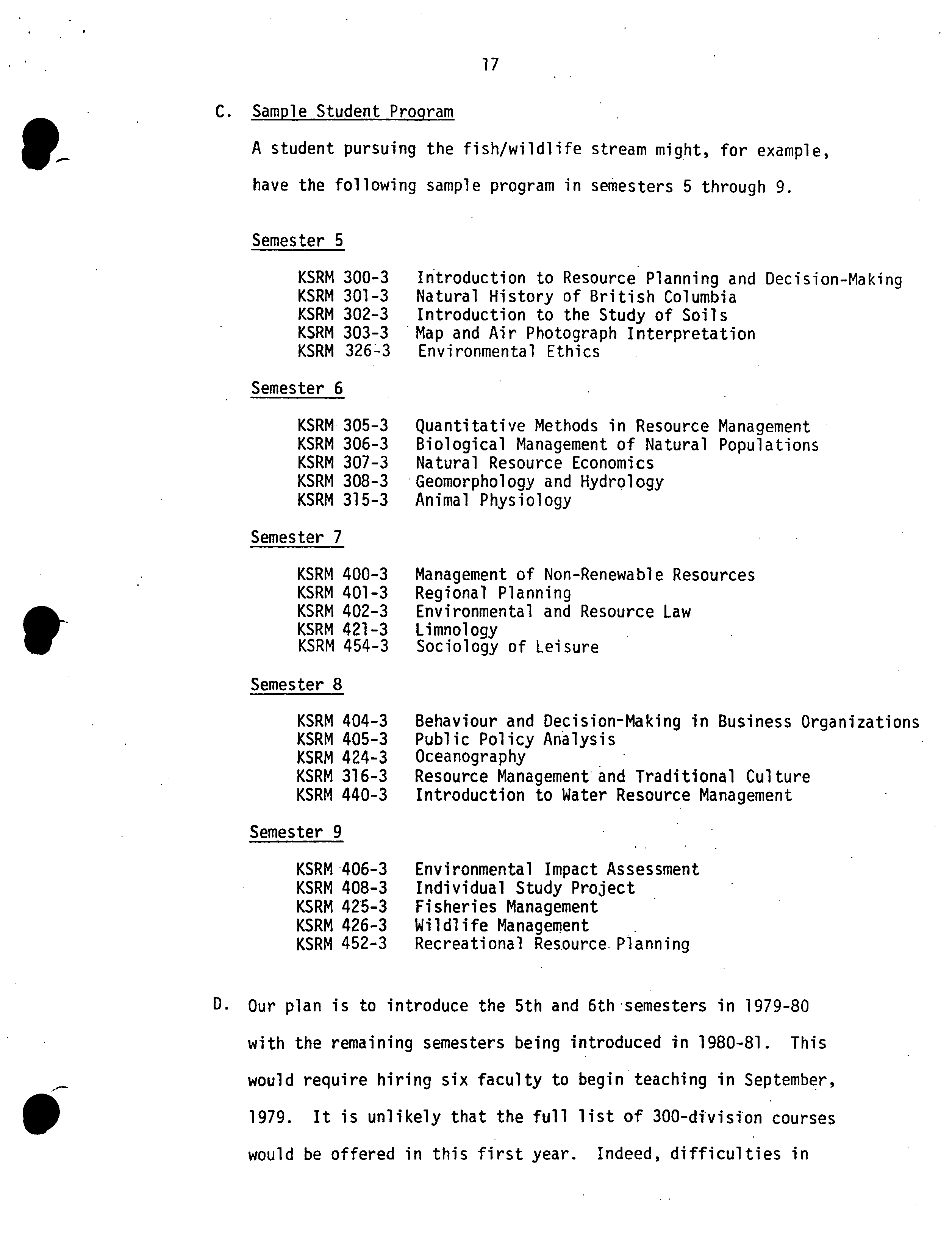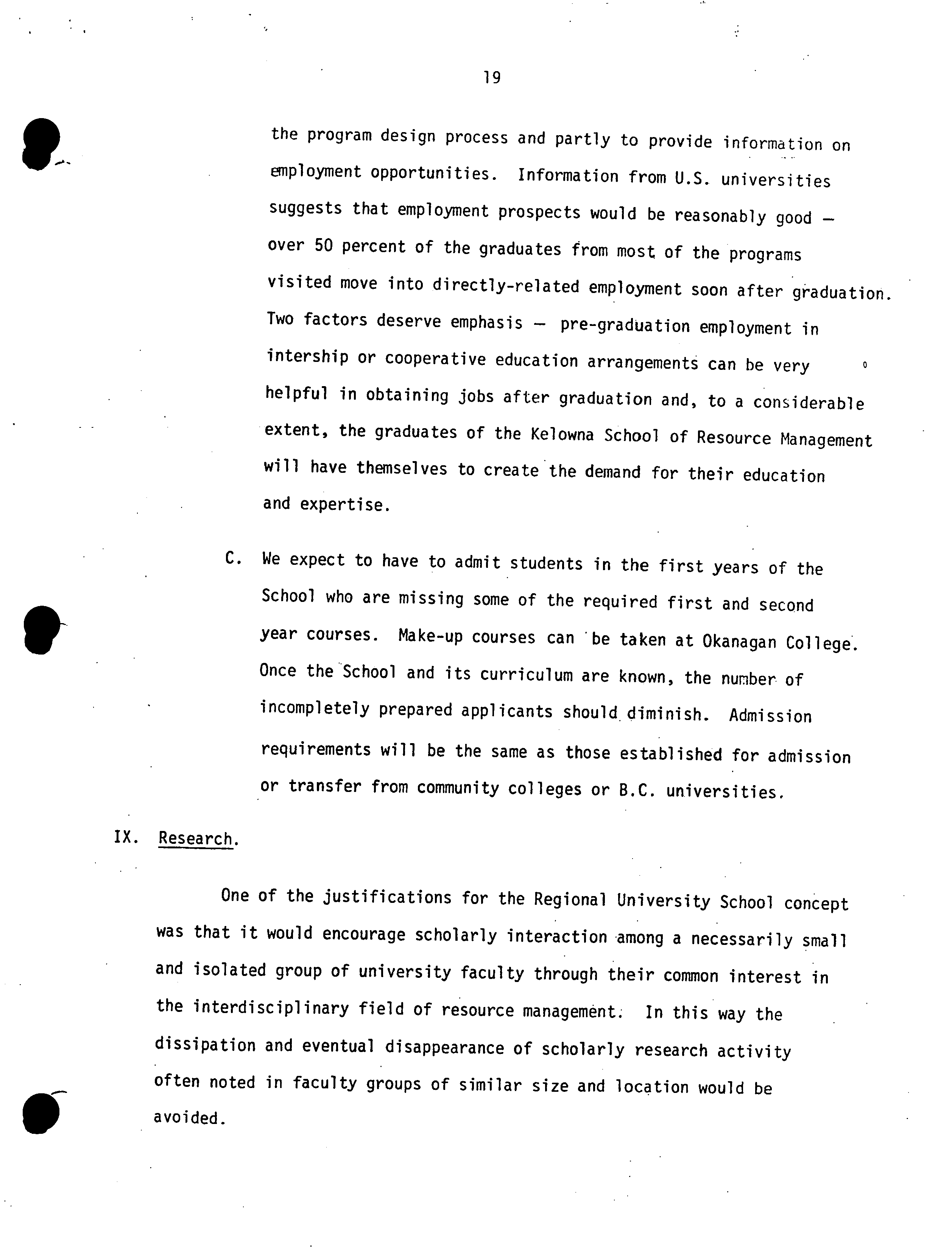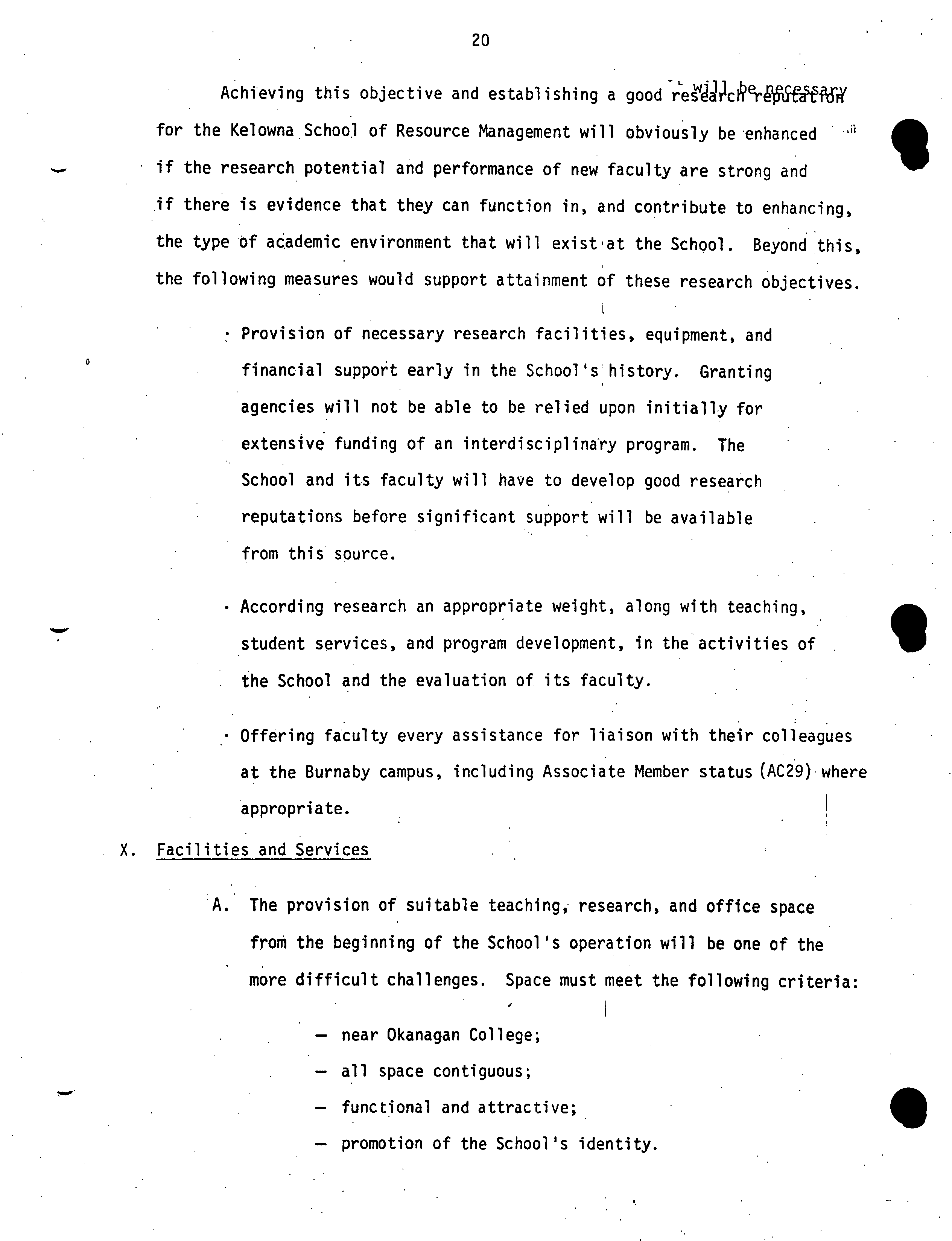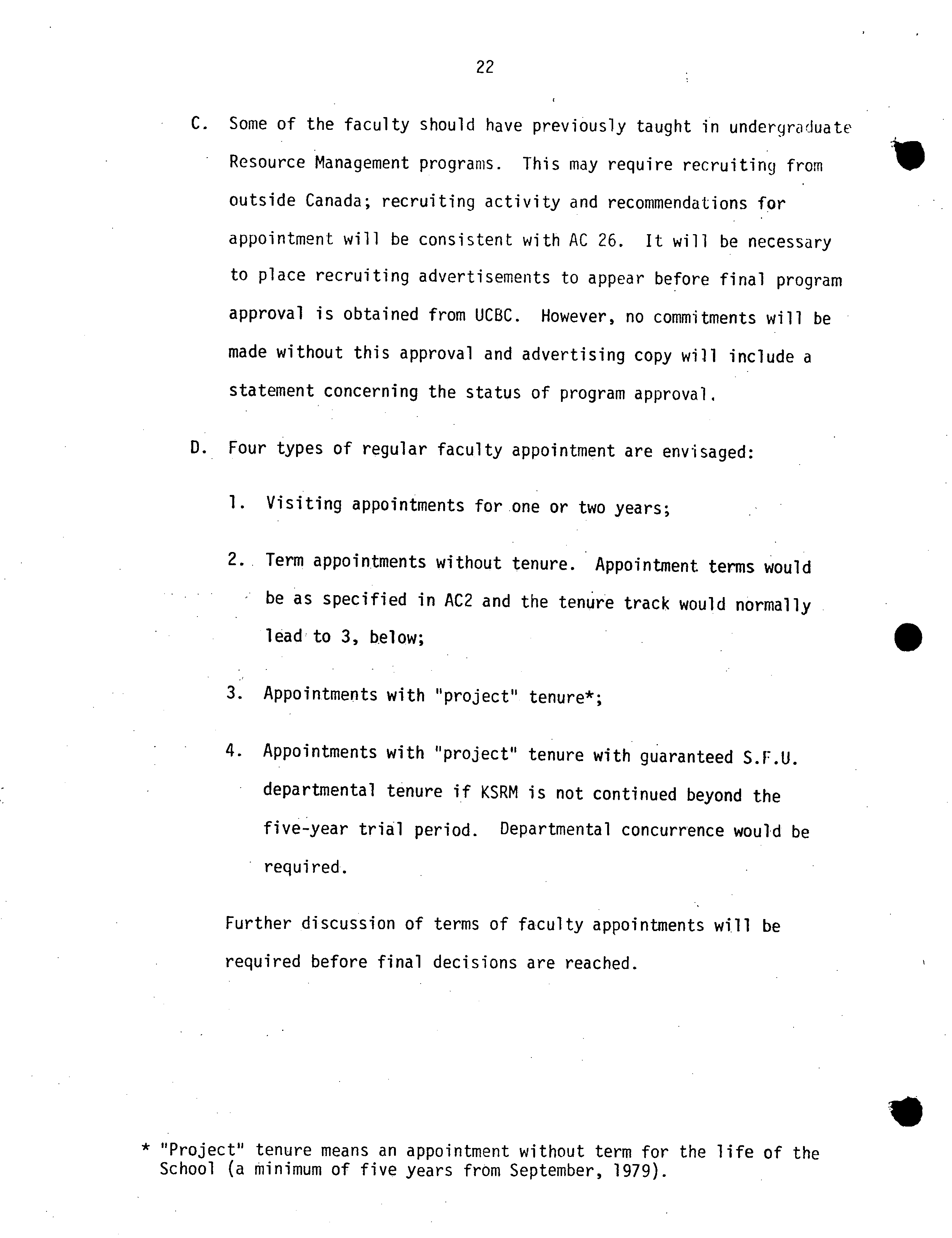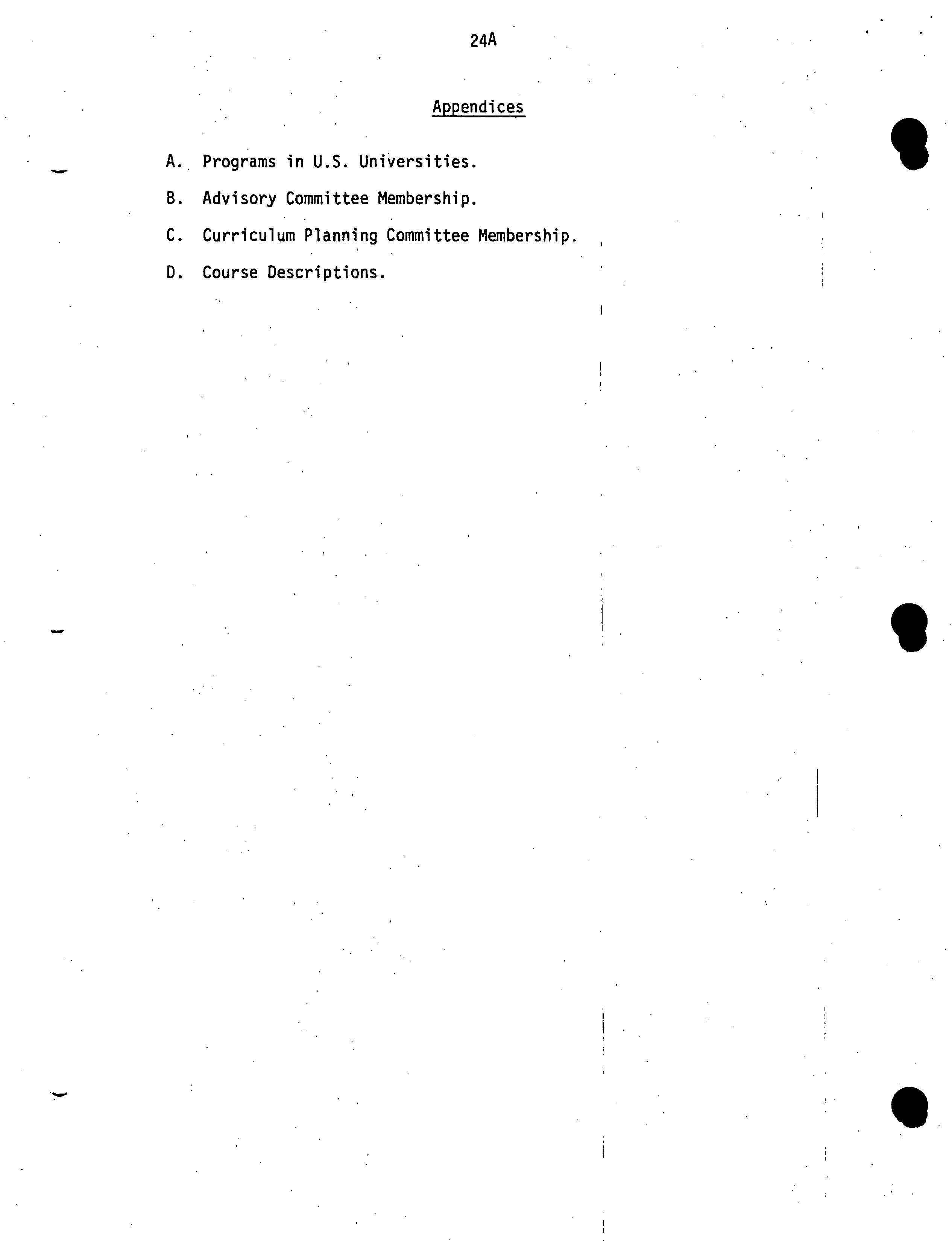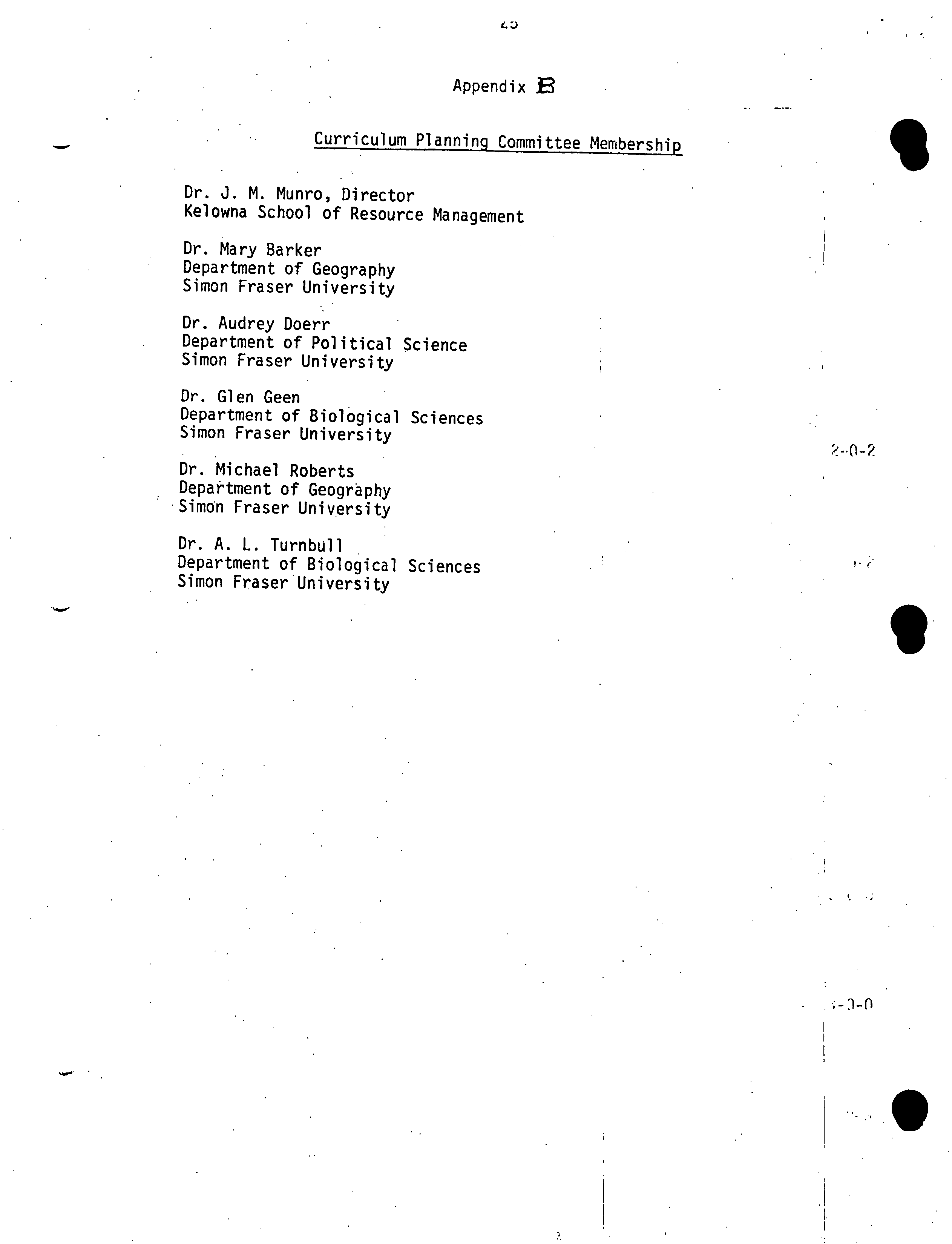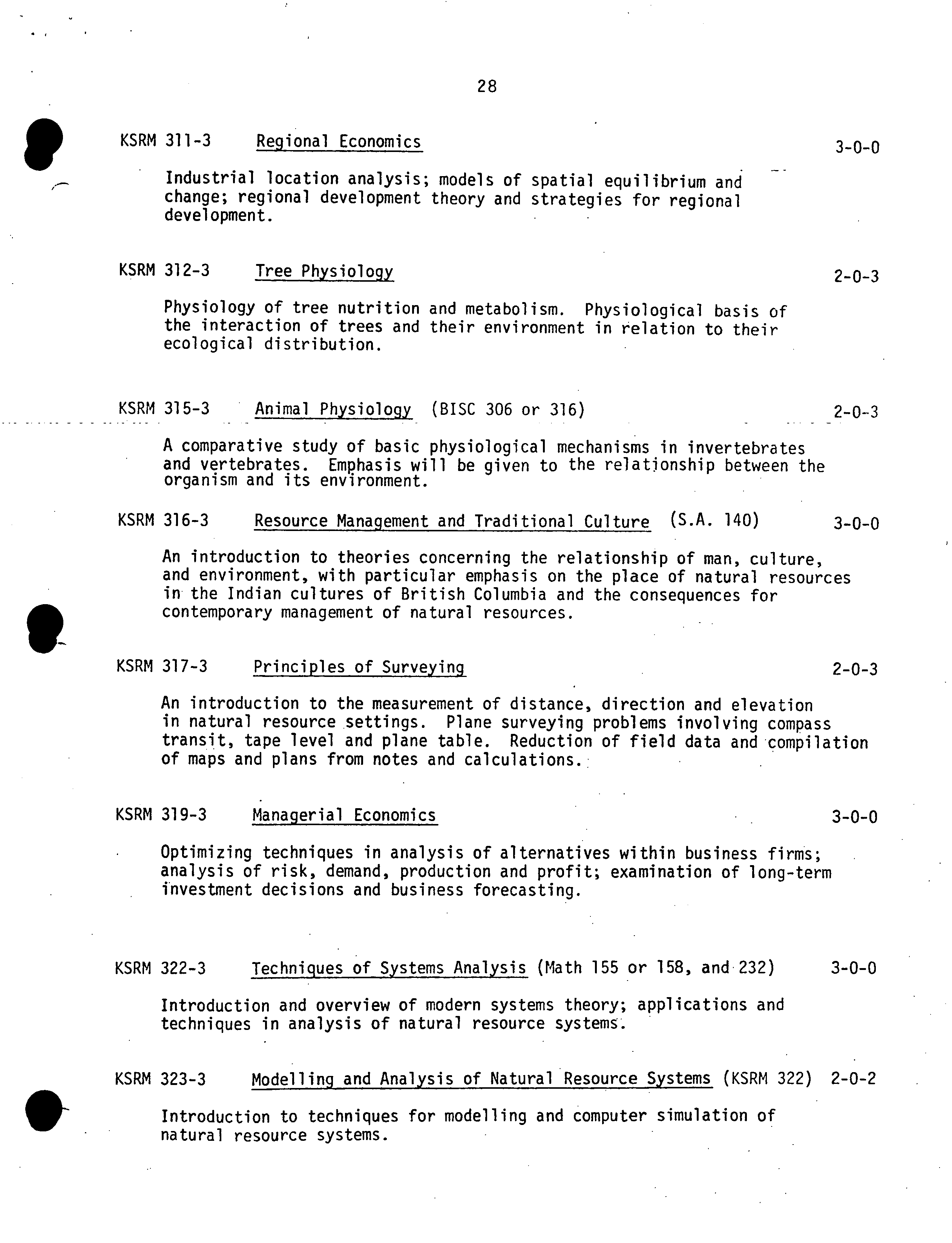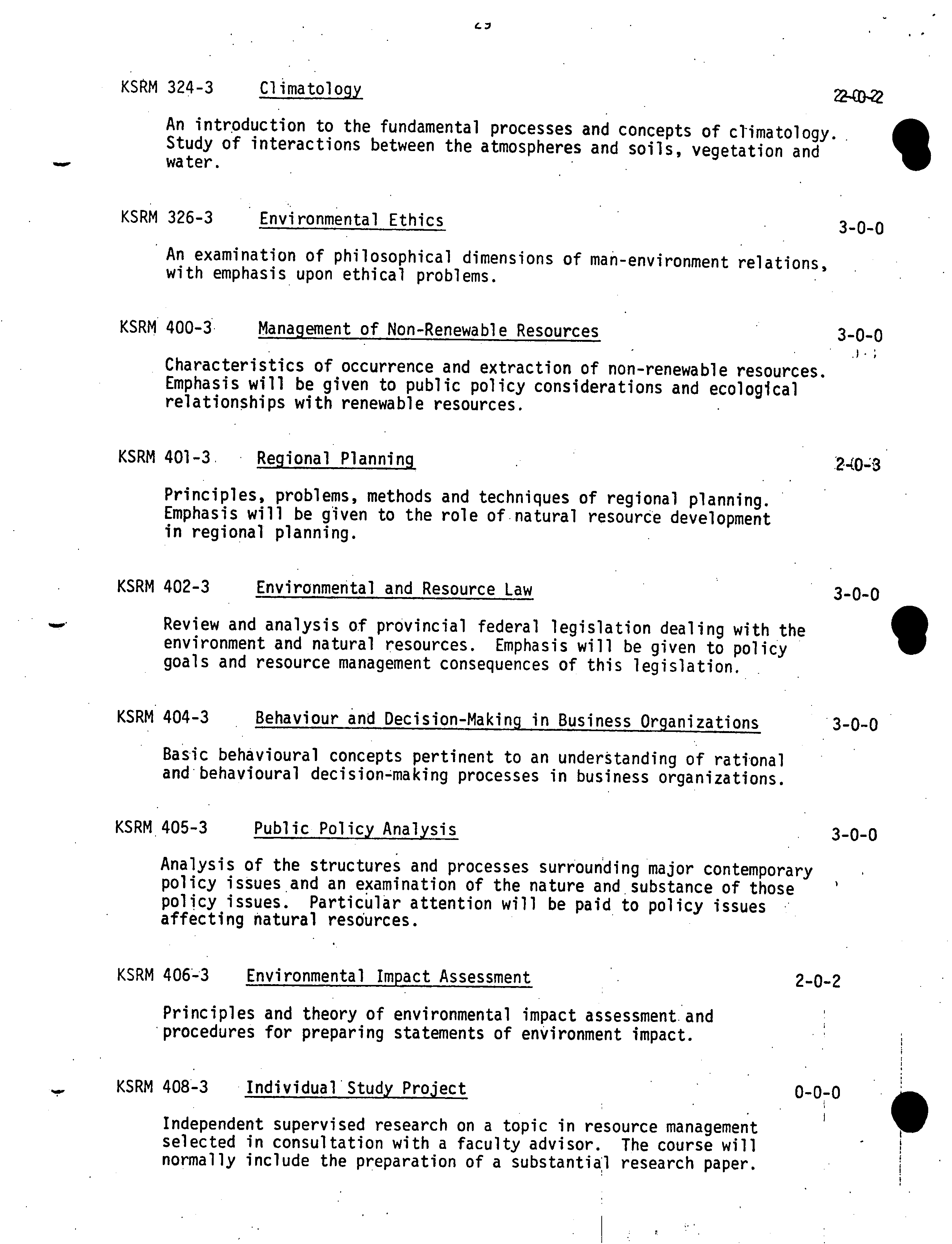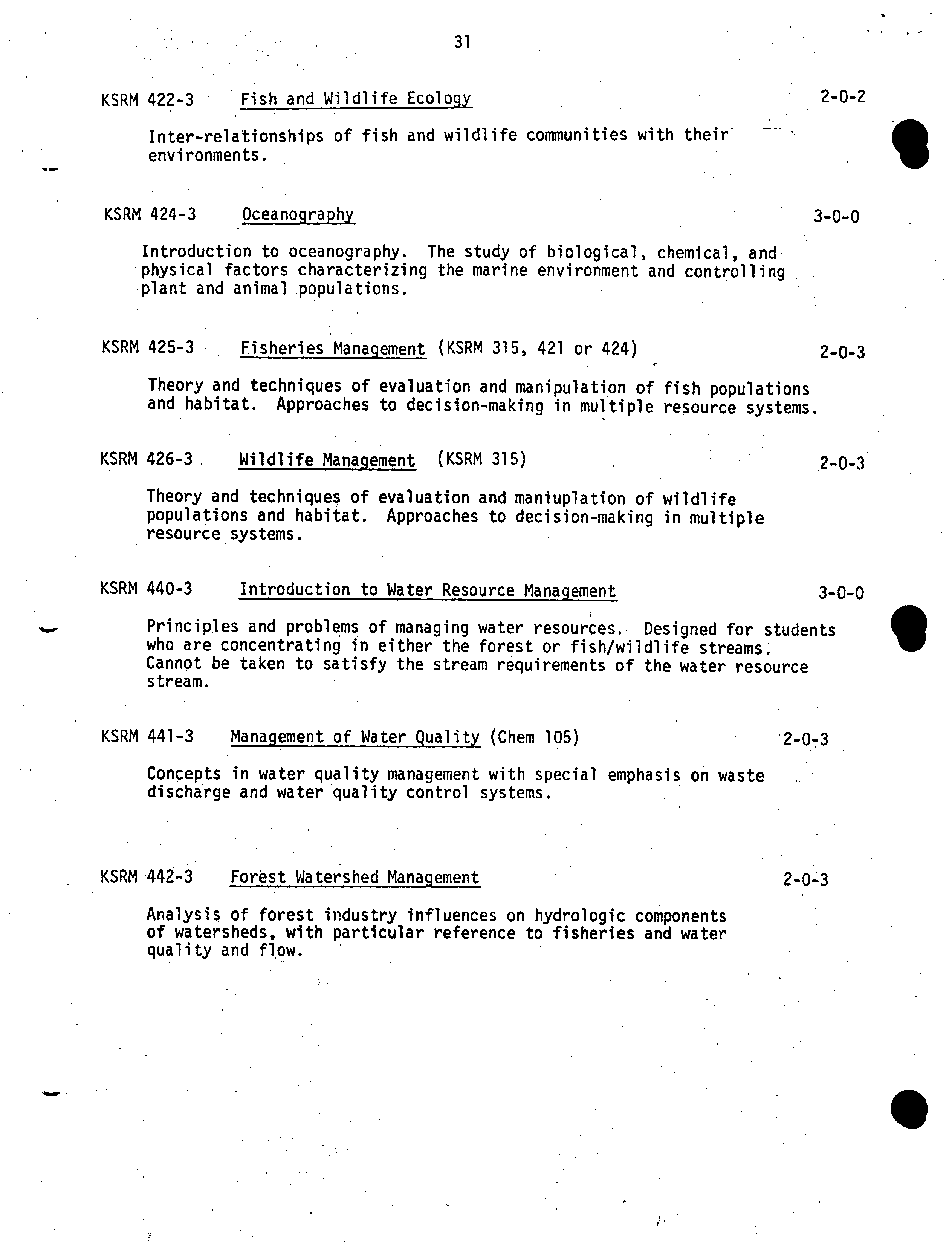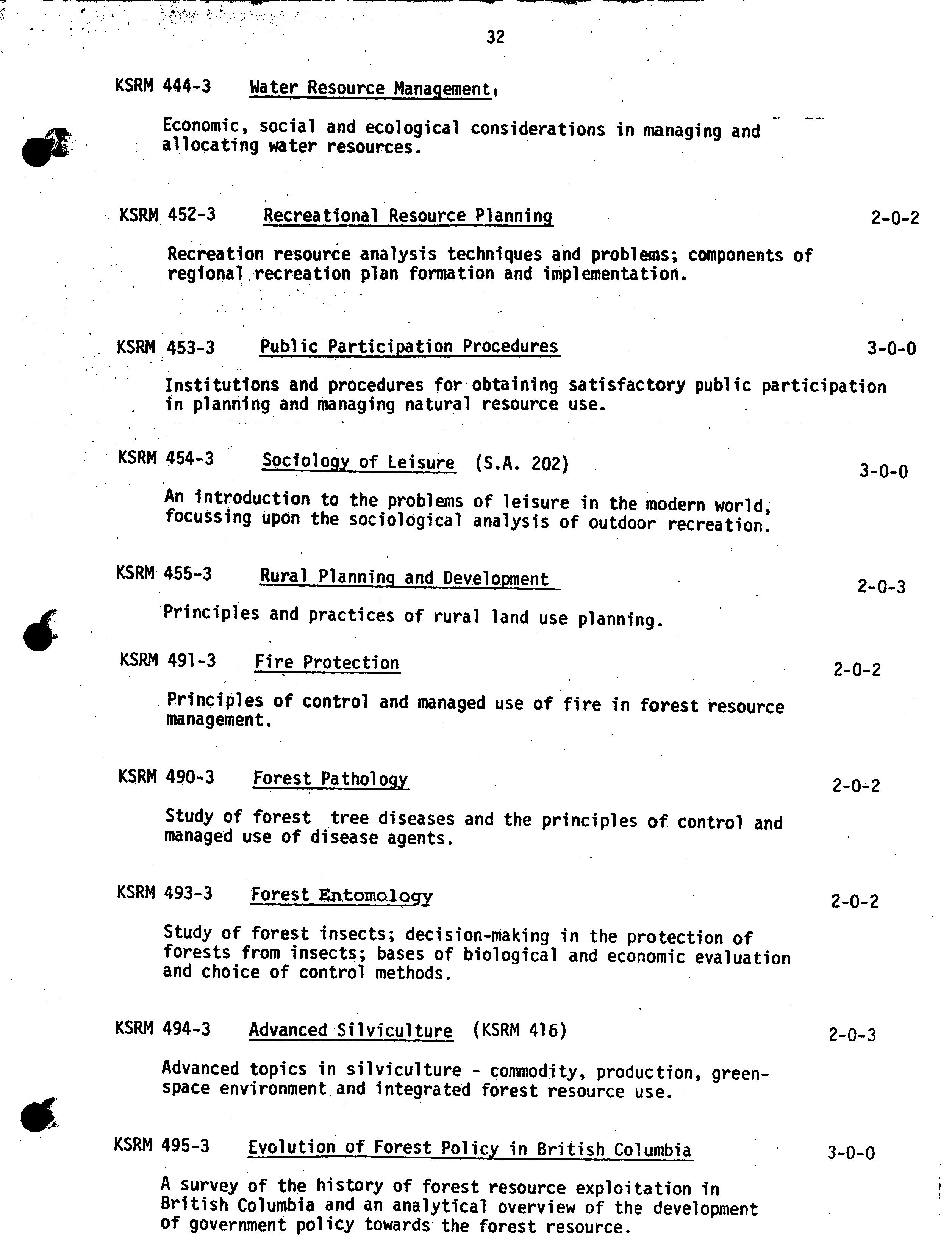• •
SiMON FRASER UNIVERSITY
S.
7(ç 130
MEMORANDUM
As adjustad and approved
by Senate November 20,1978
To..........
Senate
.
.......................From...
N. R.
Reilly, Chairman
Senate Coninittee
.
. on UndergraduateSt dies
Sub ject..
P1:0
r
g
am
cpceal...Keliwra SChOO1
.Date..
1978-11 1-10
of Resource Manageirent
Following the Winegard Com
or m
Tni
iss s i s ons
ion
' Report in
1976,
Universities Council
provided funds to enable Simon Fraser University to develop a detailed plan
for providing degree completion opportunities to non-metropolitan areas in the
Province. The resulting SFU plan contained proposals for seven regional
university schools as well as a package of distance learning systems. General
endorsement'. of the concepts contained within the Interior Programs Planning
Committee Report was given by SC1P and Senate in the Fall of
1977.
In late
1977,
the former Interior University Programs Board approved initiation of a
Kelowna-based School of Resource Management and sent a recommendation to this
effect to the Universities Council of British Columbia with a request that
funding be provided over a five-year period. This was initially rejected by
the Program Coordinating Committee of UCBC but a revised proposal for a
Kelowna School of Resource Managerrent was approved in principle by SC7\P and
Senate in early 1978.
The Universities Council of British Columbia approved
the program in principle but requested more detailed information on curriculum
and program delivery before providing major funding. Funding and authorization
were given, however, for a year of more detailed planning. Extensive invest-
igation and planning has led to the current more detailed proposal.
The present proposal for the Kelowna School of Resource Management was
discussed in considerable detail at the meeting of the Senate Committee on
Undergraduate Studies on Tuesday, November 7,
1978.
The Senate Committee on
Undergraduate Studies recognized that, in the absence of the faculty who would
be responsible for mounting and teaching the program,: it was not reasonable
to expect so much by way of detailed course outlines as is customary for
courses to be taught on campus, developed by the faculty who expect to teach
them. The Committee's approval of the courses in the Kelowna School of
Resource Management was therefore on a "pro teirpore" basis on the understanding
that the courses would be brought back to SCUS for review within one year of
first being offered.
Action at the meeting of the Senate Committee on Undergraduate Studies
on Tuesday, November
7
gives rise to the following notion:
MOTION: That Senate approve and recoirnend approval to the Board of Governors
the proposal for the Kelowna School of Resource Management as set
forth in
S78-130 ,
including in particular, the following features:
i) the establishment of two degrees:
Bachelor of Science (Resource Management)
Bachelor of Science (Forest Resource Management)
•
2
Senate
- 2 -
1978-11-10
but,
ii) that both degrees be General Degrees/without a specific Major
subject, with a requirement of a graduation grade-point average
of 2.0 calculated on all the courses taken from the Kelowna
School of Resource Management used for credit toward the degree
(excluding duplicate courses), and subject to the fulfilment of
the requirements as outlined in paragraphs (iii) and (iv) below;
iii) students transferring into the School may be given course
transfer credit for specific KSPi 300- and 400-division
courses. However, at least 60 hours of the 75 hours required
for the B.Sc. (Resource Management) and at least 75 hours of the
90 hours required for the B.Sc. (Forest Resource Management) must
be taken from the Kelowna School of Resource Management;
iv) Curriculum requirements:
a)
first and second year required courses as outlined on page 13A;
b)
first and second year reconinended courses, as outlined on pages
l31 and B;
c)
program for semesters 5 and 6 as specified on page 14;
d)
program for semesters 7, 8, 9, and 10, as specified on pages
15 and 16.
v)
Approval "pro
teiipore" of each of the new courses proposed on
pages 27-32:
KSRM
300-3
-
Introduction to Resource Planning and Decision
Making
KSPM
301-3
-
Natural History of British Columbia
KSBM
362-3
-
Introduction to the Study of Soils
KSRM
303-3
-
Map and Air Photograoh Interpretation
KSRM
305-3
-
Quantitative Methods in Resource Management
KSRM
306-3
-
Biological Management of Natural Populations
KS-T1 307-3
-
Natural Resource Economics
}(S1
308-3
-
GealDrç*loloqy and Hydrology
KSRM
310-3
- Agroecosystems
KSRM
311-3
-
Regional Economics
KS-T1
312-3
-
Tree Physiology
KSRM
315-3
-
Animal Physiology
KSRM
316-3
-
Resource Management and Traditional Culture
KSRM
317-3
-
Principles of Surveying
KSRM
319-3
- Managerial Economics
KSPN
322-3
-
Techniques and Systems Analysis
KS4
323-3
-
Modelling and Analysis of Natural Resource
Systems
3
Senate
- 3 -
1978-11-10
•
KSI4
324-3 - Climatology
KSR4
326-3 -
Environmental Ethics
KSR4 400-3 -
Management of Non-Renewable Resources
FSR4
401-3 -
Regional Planning
KSI4 402-3 -
Environmental and Resource Law
R4
404-3 -
Behaviour and Decision-Making in Business
Organizations
KSI4
405-3 - Public Policy
Analysis
}11 406-3 -
Environmental
IiTIact
Assessment
KSR'1
408-3 -
Individual Study Project
KS!4 410-3 -
Introduction to Forest
Rouice
Management
KS1
412-3 -
Forest Ecology
KSI4
413-3 - Forest Mensuration
KSW 414-3 -
Range Management
YSR4
415-3 -
Forest Harvesting
KSR4
416-3 - Silviculture
IcS4
420-3 -
Introduction
to
Fish and Wildlife Management
KS14
421-3 - Limrlogy
KSR4
422-3 -
Fish and Wildlife Ecology
IcSR4 424-3 -
Ocecrzgraphy
KS4
425-3 - Fisheries Management
KSRK 426-3 - Wildlife Management
KSRM 440-3 -
Introduction to Water Resource Management
KS14
441-3 -
Management of Water Quality
KSR1
442-3 -
Forest Watershed Management
KSI4 444-3 -
Water Resource Management
KSR4
452-3 -
Recreational Resource Planning
IcSR4
453-3 - Public
Participation Procedures
KSRM 454-3 -
Sociology of Leisure
KSR4
455-3 -.
Rural Planning and Development
I(SR4
491-3 -
Fire Protection
KSI4
490-3 -
Forest Pathology
KSRM
493-3 - Forest Entomology
KSR v
I
494-3 -
Advanced Silviculture
KSRM
495-3 -
Evolution of Forest Policy in British Coluithia
N.R. Reilly
SiMON FRASER UNIVERSITY
'
N.
,
J. M. Munro, Director
o...........
MEMORANDUM
RReilly,
Chairman
..................................................................... From..
.
Senate Committee on
U.n.d.e.r.g.r.a.du.a.t.e....S.t.u.di.e.s ..... ... ........ ..... . .... .......
... ..........
Kelowna Schoo.of
.
espurçe .anagement
Subject..P.r.9 g.r.M1
Pro
.
posa., .el own a School of
.
Date....
October
30-,.1.97.8
Resource Management
Attached is the program proposal for the Kelowna School of Resource
Management. This is a revision and elaboration of the program considered
by SCAP and Senate earlier this year. The earlier program was considered
by Universities Council last April but did not receive final approval
Instead, the University was authorized and funded to undertake- aothe
period of planning. The current program proposal reflects this additional
planning effort.
Both SCAP and Senate gave approval in principle to the Kelowna School
of Resource Management program earlier this year. This followed general
endorsement of the concepts contained within the Interior Programs Planning
Committee Report by SCAP on September 21, 1977 and by Senate on October 3,
1977. (S. 77-101). At its meeting of January 25, 1978, SCAP approved
the following motion:
"that the Senate Committee on Academic Planning approve in
principle the general philosophy of the program for the
Kelowna School of. Resource Management and recommend approval
to Senate."
At the Senate meeting of February 6, 1978, the following motion was approved:
"that Senate approve in principle the program as set out in the
attached report (5. 78-13) regarding the School of Resource
Management in Kelowna."
Because of these earlier approvals, the Chairman and Secretary of Senate
have agreed that SCAP consideration of this detailed program revision is
unnecessary.
The program planning process is outlined in the program document.
It has involved extensive consultation inside and outside the University.
I draw your attention particularly to the contribution of the Curriculum
Planning Committee. Thus, while the Kelowna School of Resource Management
program proposal has not been considered by a Faculty curriculum committee
(the School is not designed to be part of a Faculty), it has been widely
reviewed. I am sending a copy of this program proposal to Chairmen of
the Faculty curriculum committees and informing Department Chairmen of
the proposal.
2
.2
If SCUS approves the proposed program, it will be considered at a
special meeting of Senate on November 20, 1978. Approval at this stage
would permit consideration by the Program Co-ordinating Committee of
Universities Council on December 8th and by Council itself on December
18th. Approval at each stage with this timing is virtually essential
if the School is to begin offering courses in September, 1979.
JMM/lmb
cc: H.M. Evans
If
ng
U
.tTh,.
SiMON FRASER UNIVERSITY
MEMORANDUM
9'T_0 ..........
See distribution list below.
b
Program Proposal, Kelowna School of
Su I
ect. Resource . Ma fl agem . ent . .
Dr. J. M. Munro, Director
From..
............................
Kelowna School of Resource Management
October 31, 1978
Date
Attached is the Program Proposal for the Kelowna School of Resource
Management. It will, I understand, be considered by the Senate Committee
on Undergraduate Studies at its meeting of November 7, 1978
Prior to your receiving the SCUS papers I thought I would draw your
attention to the issue of overlap between Kelowna School of Resource Manage-
ment (KSRM) courses and departmental courses at Simon Fraser. Some proportion
of the KSRM course material is contained in courses presently included in
departmental curricula. However, theoverlap between KSRM courses and
departmental courses seems inevitable and, in fact, necessary. Regional
University Schools have been conceived as self-contained academic units
operating in a location remote from our main campus and offering an
integrated curriculum. The curriculum of the Kelowna School of Resource
Management focusses on the management of natural resources and necessarily
contains material in the natural and social sciences that is contained
in departmental courses. However, few of these courses would in practice
'
be exact counterparts to KSRM courses because of the special professional
orientation of the KSRM program and because different faculty will be
teaching the courses. For these reasons, we hope that SCUS will accept
the overlap between the KSRM courses and existing departmental courses.
The issue of transfer credit between departmental courses and
KSRM courses still remains to be dealt with. As pointed out
in
Section VII
of the course proposal, decisions of this type must await the appointment
of School faculty and the development of detailed course outlines and
bibliographies. Only then will the necessary discussions with departments
concerning course equivalencies be possible.
Distribution: Dr. W. Roberts, Chairman, Faculty of Arts Curriculum Committee
Dr. M. Wideen, Chairman, Faculty of Education Curriculum Committee
Dr. J. Dickinson, Chairman, Faculty of Interdisciplinary Studies
Curriculum Committee
Dr. L. Kemp, Chairman, Faculty of Science Curriculum Committee
cc: Department Chairmen. (Copies of the program proposal can be obtained
by telephoning Linda Bradley at 4797.)
D. R. Birch
•
N. R. Reilly
'H. M. Evans
JMM/lmb
rograms Board
•
PROGRAM PROPOSAL
•
nement and
KELOWNA SCHOOL OF RESOURCE MANAGEMENT
S
I. Simon Fraser University Plan for Interior University Programs.
In the Spring of 1976, the Government of British Columbia established
the Winegard Commission on University Programs in Non-Metropolitan Areas.
Later in the year the Commission recommended that a new division of Simon
Fraser University or, alternatively, a new university, should have responsi-
bility for providing degree completion programs
in
the non-metropolitan areas
of the Province. The Commission's report was considered in detail by Simon
Fraser University during the Fall of 1976 and, as a result of internal
deliberations, money was sought and received from the Universities Council
to develop a detailed plan. The S.F.U. Interior Programs Planning Committee
Report was submitted on September 15, 1977 to the Universities Council and
to the Ministry of Education.
The S.F.U. plan provided a two-pronged approach to degree completion
.1,1
It included a basic distance learning system developed to meet British
• Columbia's unique needs which would largely be based, like the Open
University
in
the United Kingdom, on correspondence materials supplemented,
as appropriate, by tutorials and radio and television broadcasting. This
responsibility is now to be shared. by the universities and the Open Learning
Institute. Rather than the university centres suggested by Dr. Winegard,
which we felt to have limited viability both economically and educationally,
we developed the concept of the Regional University School.
A
Regional University School would be a university unit placed in an
Interior location, establishing a university presence
in
the area and offering
•
classroom-based instruction to students in a focussed interdisciplinary
completion program. A School would be an integral part of Simon Fraser
University, making use of the full range of the University's academic support
2
p
a-
r
L
services, but designed to operate with a considerable degree of administrative
autonomy. Faculty members would be appointed to the School, not to academic
departments, and the School would not be part of one of the University's
Faculties. Faculty members would, of course, be mmbers of Joint Faculty
and Convocation.
In the development of a School program, a curriculum would be designed
to meet the needs of the region and the teaching and research functions of
a School would complement each other. The research would take advantage of
the opportunities and problems presented by the region in which a School
would be located. An overall assumption was that students, attracted by
the uniqueness and excellence of School programs, would come from all of
British Columbia, including the Lower Mainland, and perhaps from other
provinces as well.
In appendices to the Report, we suggested certain kinds of programs
which we felt would be viable in different locations within the Province.
One of these was a School of Resource Management.
Il. School of Resource Management Proposal.
Simon Fraser University selected the School of Resource Management
from the seven Regional University School models for development in the
Fall of 1977. The Resource Management model appeared to be easier to
develop than some of the others and it was believed to be capable of
meeting important educational needs in the Province, particularly in the
Interior. Kelowna was designated as the location of this School because
of the strong interest there in university degree programs that was made
apparent during the Winegard Commission and the work of S.F.U.
'S
Interior
Programs Planning Committee. Other important factors were the rich mix of
resource endowments in the Okanagan region and our previous experience
in offering degree completion programs in Psychology and Biological
Sciences in Kelowna.
In late 1977, the former Interior University Pro
q
rms Board
r
s1ty presently
approved initiation of a Kelowna-based School of Resource Management and
sent a recommendation to this effect to the Universities Council (UCBC)
with a request that funding be provided over a five-year period. The
Program Coordinating Committee of UCBC did not concur with this reconimenda-
tion. ' Subsequently, UCBC.approved the program in principle but requested
more detailed information on curriculum and program delivery before
providing major funding. Funding and authorization were given, however,
for a year of more detailed planning.
Since last Spring efforts have been concentrated on appointing a
Director and, with his appointment, on undertaking an accelerated program
planning effort. The details of that planning effort are described in
the next section.
III. Program 'Planning Process.
A.
The major planning task has been to develop a curriculum and, based
on it, a budget for submission to Universities Council in December 1978. Other
aspects of planning for the Kelowna School of Resource Management are
discussed in Sections VIII through XII below; none of them, however,
have been advanced to the same point as the curriculum and related
matters.
B.
Our 'original intent last Spring was to submit a skeleton program
proposal. ' Believing that the faculty who will teach in the School must,
and will, have a decisive role In shaping its curriculum, we decided
last Winter to submit only a very general overview of the curriculum.
After approval and funding, faculty appointed to the School would have
revised and elaborated the program. However, it became appareritduring
consideration of the School of Resource Management proposal by Universities
Council and its committees that a skeleton program proposal provided
S
S
I
4
insufficient description and explanation of the program for the necessary
'
approval to be obtained.
Accordingly, the present proposal includes considerably more detail
concerning program structure and courses than was presented earlier.
We would expect the broad outline of the program to be consistent with
the philosophies and ideas of faculty appointed to the School. However,
the program presented here will undoubtedly change as faculty are appointed
and as we gain experience through teaching the program.
C. The curriculum planning process has included the following elements:
1.
A review of available material concerning the curricula of
other university programs in natural resource management
and related areas.
2.
Visits by the Director to six universities offering programs
'
in this area. The focus of the visits was on four key areas:
- program objectives;
- curriculum design and rationale;
- nature of student interests;
- post-graduation employment experience of students.
The following universities were visited:
a. University of Alaska
b.
Humboldt State University (California State. University
system)
c.
State University of New
York,
College of Environmental
Science and Forestry
d.
University of Wisconsin, Green Bay.
e.
University of Wisconsin, Stevens Point
f.
Western Washington State University.
Other U.S. universities offering undergraduate major programs
in natural resource management and environmental management
5
are listed in Appendix A. No Canadian University presently
offers an undergraduate program of the type we are proposing
for the Kelowna School of Resource Management although the
University of Waterloo comes reasonably near and the professional •rer_
forestry courses offered by Canadian universities have been taking
on a more general resource management orientation, although not
to the same degree as their U.S. counterparts.
3.
Discussion and review of draft program proposals by a Curriculum
Planning Committee consisting of six faculty members from the
Departments of Biological Sciences, Economics and Commerce,
Geography, and Political Science. Committee membership is
"irce
shown in Appendix B.
4.
Consultation with an Advisory Committee drawn from government,
industry, and education. Committee membership is shown in
Appendix C.
5.
A questionnaire survey directed at a sample of sixty potential
employers of resource management graduates. The questionnaire
is designed to elicit responses concerning overall professional
manpower needs, needs for resource managers, and preferences in
program design and emphasis. The survey's main purpose is
to provide information for the presentation to Universities
Council. The results are not available yet.
• A report will be
added to the documentation later.
IV. Program Objectives.
The establishment of the Kelowna School of Resource Management is being
proposed to serve two important objectives. The first is to provide an
Interior community and region with a University degree program that exhibits'
focus, excellence, continuity, and identification with the community and
6
region. The second objective is to offer a professional degree in resource
management leading to employment in the public or private sectors. This
requires an understanding of the basic natural and social scientific
characteristics of natural resources and their use and development of an
integrated approach to the tasks of managing resources. Through such a
professional education, it is expected that students' intellectual curiosity
will be excited and deepened in ways that will assist them.to
explore -
independently - other fields.
There is no program of post-secondary education more relevant to
British Columbia than one centered about the orderly development and
management of its natural resources. British Columbia is heavily dependent
for its prosperity upon use of these resources; hence, there is
a clear and urgent need to ensure that the resources of the Province are
developed, husbanded, and conserved in a wise and informed way and in a
,
manner that serves long-term as well as short-term goals. The appearance,
quality and productivity of the environment and the prosperity of British
Columbia's citizens will increasingly depend on resource management decisions
that are being made now and that will be made in the next decade. A body
of trained resource management personnel and a citizenry informed regarding
the characteristics of its lands, the principles of its ecology, and the
potentialities and limitations of its productivity are essential if wise
proposals are to be made and supported.
We expect that the intensity of management of British Columbia's
natural resources will increase considerably in the next few years, thereby
reinforcing the relevance and importance of the proposed program. Certainly,
despite the increased sensitivity to natural resources evident over the last
decade, resource management activity in British Columbia lags, both
quantitatively and qualitatively, behind good practice in the United States
and Western Europe.*
* These views are reinforced by a reading of the 1976 Report of the Royal
Commission on Forest Resources. There, present shortcomings and future
VA
'iblity of graduates
V. Aspects of Program Design
The curriculum proposed for the Kelowna School of Resource Management
reflects the above objectives. The curriculum has the following basic character-
istics:
A.
a bas .
ic background of relevant courses in the natural and
social sciences;
B. an integrated view of the processes and problems of natural
resource management;
C.
opportunity for specialization in one of four fields of resr1è
management;
L
D. additional
opportunity for specialization in the field of forest
resource management because of the importance of this resource
in British Columbia.
Other curriculum emphases are possible:
one woud be to offer a liberal
arts and science degree with an emphasis on natural resource or environmental
studies; another would be to offer a degree that had a stronger natural
science component; another would be to offer a professional degree with •heavy
specialization in management of particular types of natural resources.
is our view that the proposed curriculum is the most suitable for meeting
the needs of the Province in resource management education and for offering
a sound university degree program in the Interior with potential for
expansion and, in time, diversification.
.
Several
factors have acted as constraints in designing the curriculum
for the Kelowna School of Resource Management.
needs of forest resource management are discussed in considerable detail..
One relevant comparison is between the responsibilities of the U.S.
Forest
Service and the B.C. Forest Service (equivalent in terms of forest area
and timber harvest) and the staff of professional
foresters (4,897 in
the U.S.
Forest Service and 327 in the B.C.
Forest Service).
8
A. Because it is designed to offer an Interior_based degree
program, the School will not teach first and second year
courses. These will be taken at community colleges in the
Interior (or elsewhere in the
P
rovince), at the universities,
or through the Open Learning Institute. This makes it impossible
to require courses from entering third year students that are
not
g
enerally available at the community Colleges. However,
we do intend to press for the offering of a general lower
division course in natural resource management at some colleges,
the
un
iversities and through distance education.
B. The curriculum includes a core of courses in the natural and
social sciences and in the techniques of resource management
and Planning. Each student selects a "stream" containing
courses of particular
r
elevance to one type of natural resource.
,
-
Initially, four streams are proposed: forest
r
esources, fish
and Wildlife
r
esources, water resources, and resource Planning.
Both the core and the streams contain required and elective courses,
Some of the,courses are
s
ufficiently broad and integrated to require
team teaching.
C. The
con
centration of all Specialized courses in the last 2
1
2
years
means that in-depth
sp
ecialization will not be Possible within
the proposed
4 ½-
y
ear B.Sc. (Resource Management) program. The
only in-depth s
p
ecialization offered will be in the proposed
5-year B.Sc. (Forest Resource
M
anagement') program.
D.
The
curriculum is designed and the budget based on an initial
complement of 15 faculty members and 150 students. Additional
ins tructional
a
ssistance will be required from
La
boratory Instruc-
tors and, perhaps, Teaching Assistants.
9
E.
Initial explorations have been made of thepossiblity of
i
qraduates
requrements
from the Kelowna School of Resource Management obtaining registered
professional status in the Association of British Columbia Professiona
Foresters, the Canadian Institute of Planners, or the B.C. Institute of
Agrologists. It appears that this would be possible
in
the
first two groups but not in the third. Registered Professional
Forester status would be easier to obtain for students who had
taken the extra tenth semester of specialized courses in forest
resource management.
F.
Articulation with various two-year programs in resource management
technology offered by the British Columbia Institute of Technology
and three community colleges (Malaspina, New Caledonia, Selkirk)
presents a difficult problem. These technology programs include
some courses in the same areas as those offered in the last five
semesters of Kelowna School of Resource Management. However,
these technology courses are not preceded by the basic science
prerequisite courses of the first two years. Because of this,
we do not feel that it is appropriate to grant general transfer'credit
for technology courses. However, we are prepared to make all
Kelowna School of Resource Management courses available for credit via
the course challenge mechanism and to consider direct course
transfer credit for selected technology courses.
G.
Some courses in the Kelowna School of Resource Management will
be available on a credit basis to students who are not pursuing
a degree program. In addition, we expect to institute an
"ExtendedStudies Diploma" for persons who have university
degrees but who wish to augment their academic background by
taking a co-ordinated set of Kelowna School of Resource Management
S
.
10
courses. We expect to offer part of the program in the evening
to facilitate the attendance of part-time students.
H.
We intend to develop extensive related work experience for students
in the summers of the third and fourth years. Student summer
employment in jobs related to their academic program is regarded
as an important and valuable feature of many resource management
programs. The extensive resource management activities of the
Okanagan and the rest of the Interior should allow the School
to make arrangements that reflect the importance of related -
work experience.
I.
Graduate students from the three British Columbia universities
could be acconiodated at the Kelowna School of Resource Management
where their areas of research coincided with particular areas
'
of interest of faculty members or where there were particular
regional research opportunities. Such students might be employed
as teaching assistants by the School. We do not plan, however,
to offer graduate courses or a graduate degree program at the
Kelowna School of Resource Management, at least in its initial
phase.
J.
Students obtaining a B.Sc. (Resource Management) should be eligible
for
entry
into the following types of master's level graduate
programs:
- planning;
- forestry;
biology or geography (with a qualifying year);
- Master of Business Administration;
- Master of Pest Management;
- Law
11
Students will be advised that information on course requirements
and admission should be obtained directly from the university
offering a particular graduate program.
The new Master of Resource Management program at Simon Fraser
University is a professional degree program designed for students
with a disciplinary major in a B.A. or B.Sc. program.
Thus, the
program is not particularly well-suited for direct entry for
graduates of the Kelowna School of Resource Management.
However,
a studentwith a degree from the School might find the M.R.M.
program more suitable following a few years of experience in
the field of resource management.
VI. Degree Requirements.
Both degrees are general degrees without a specific major.
The degree,
Bachelor of Science (Resource Management), will require a minimum of 135
semester credit hours, as shown in the next section.
The degree, Bachelor
of Science (Forest Resource Management), will require a minimum of 150
semester credit hours, as shown in the next section.
Graduation will
require a grade-point average of 2.0 calculated on all the courses taken
from the Kelowna School of Resource Management used for credit toward the
degree, (excluding duplicate courses).
VII. Program Structure and Courses.
A. Some general comments are required to introduce this section.
1.: Appendix D contains the following information for each
course: course title, credit hour value, vector, pre-
requisites, course description. Course outlines and
bibliographies are not included - these must await the
•
appointment of faculty.
2. The number of credit hours per course has been set at 3.
It is conceivable that modification in the standard 3-hour
12
credit per course will be sought once course content
has been more finely determined.
3.
No seminar or tutorial hours are indicated in the vectors,
the allocation of class time being only to lectures or to
laboratories. However, many of the courses would undoubtedly
be taught with seminar or tutorial format, as determined by
faculty members.
4.
Some KSRM courses are equivalent to courses offered in
S.F.U. departments and these equivalencies should be
noted so that students may transfer from the Kelowna School
of Resource Management to the Burnaby campus with a minimum
of difficulty. However, this cannot be done until detailed
course outlines are available.
r
L
5. Students transferring into the School may be given course
transfer credit for specific KSRM 300--and 400-division courses.
However, at least 60 hours of the 75 hours required for the
B.Sc. (Resource Management) and at least 75 hours of the 90
hours required for the B.Sc. (Forest Resource Management)
must be taken from the Kelowna School of Resource Management.
6. Laboratory hours will consist of a mixture of regular
laboratory and field experience hours. It is highly
desirable that extensive field experience be available at
all levels in the Kelowna School of-Resource Management.
El
13A
B.
Curriculum.
First
and
Second Year Required Courses (Semesters
1-4)
S.F.U.
S.F.U.
TITLE
O.C.
Biological
Sciences
BISC
101-4
Introduction to Biology
Biol 121-3 or
122-3
BISC
102-4
Introduction to Biology
Biol
111-3 or
122-3
BISC
204-3
Introduction to Ecology
Biol
222-3
Economics
ECON200-3
Principles of Economics
(I)
Econ
211-3
Ilicroeconomic Principles
ECON
205-3
Principles of Economics
(II)
Econ
221-3
Macroeconomic Principles
English
Any
ENGL
100-
Introduction to Fiction, or
Engl
111-3 or
division
course-3
Introduction to Poetry, or
121-3
Introduction to Drama
Geography
GEOG
111-3
Physical Geography
Geog
121-3
GEOG
112-3
Introductory Geology
Geol
111-3
Mathematics
MATH
101-3
Introduction to Statistics
Math
121-3
Political
Science
POL.
221-3
Introduction to Canadian Govt.
Poli
Sci
111-3
TOTAL HOURS
32 (35)*
30
*
In addition
completed a
to this list of courses, students will be expected to have
3-hour course (not
yet
developed)
entitled
'Introduction
to
Natural Resource
Management."
First
and Second Year Recommended Courses*
S.F.U.
S.F.U.
Title
O.C.
Anthropology
S.A.
140-3
Introduction to Anthropology
Anth
121-3
Biological Sciences BISC 306-3
BISC 336-3
Chemistry CHEM 104-3
CHEM 105-3
CHEM 115-2
CHEM 251-3
CHEM 256-2
Invertebrate Biology
Vertebrate Ciology
General Chemistry I
General Chemistry II
General Chemistry Laboratory
Organic Chemistry I
Organic Chemistry Laboratory I
Chem 111-3
Chem 112-3
Chem 212-3
0
Psychology
PSYC
101-3
Introductory
Psychology
Sociology
S .A.
150-4
Introduction to Sociology
S .A.
202-4
Modern
Industrial Society
Psych 111-3 or 121-3
Soci 111-3
L1
PA
13B
L
S.F.U.
S.F.U. TITLE
O.C.
COMM
221-3
Introduction to Accounting
Buad
111-3
CMPT
105-3
Fundamental
Concepts of
Computing
CoSc
111-3
M
A
TH 154-3,
Calculus I
and
II for the
Math
112-3
MATH 155-3
Biological Sciences
Math
122-3
or
MATH
157-3,
Calculus I and
II for the
Math
112-3
MATh
158-3
Social Sciences
Math
122-3
PITH
232-3
Elementary Linear Algebra
Math
221-3
Commerce
Computing Science
Mathematics
Physics
PHYS
101-3
General
Physics I
PHYS
102-3
General
Physics II
Phys 112-3
Phys 122-3
Political Science
FOL. 222-3
POL. 251-3
Introduction
to Canadian Politics
Introduction to
Canadian
Public
Administration
*
Elective
courses
in the first
and
second years
should mainly be chosen
'
from, this list.
Courses
should
be selected according to students'
program
goals
and
in light of pre-
requisites for third and fourth
year courses. Students are
strongly
urged to
contact
the Kel
ow
na
School
of Resource Management for course selection advice no later than
the end of their first semester of post-secondary education.
Admission to the
School
requires carpletion of a minimum of 60
semester
hours of
S.F. U.
courses with.
a grade-point average of 2.0, or Of work
transferable to
Simon
Fraser University under the normal calendar regulations of the University as to transfer
credit
and
grade-point average for admission to S . F .U. (Subject to the details of the
specific regulations this
normall y
represents an admission grade-point average of 2.0
on transferable
courses
from the B.C. Regional Colleges
and
Public Universities,
and
of
2.5
from
other Canadian
Universities.)
1^
14
Semesters 5 and 6
Students take the core courses and one elective course in each of the 5th and
6th semesters. Electives should be selected after consultation with a faculty
advisor and with reference to pre-requisites required-for fourth year "stream
courses.
Semester 5 - Core
KSRM 300-3
Introduction to Resource Planningand Decision-Making
KSRM 301-3
Natural History of British Columbia
KSRM302-3
Introduction to the Study of Soils
KSRM 303-3 Map and Air Photograph Interpretation
Semester 6 - Core
.
KSRM 305-3 Quantitative Methods in Resource Management
KSRM 306-3
Biological Management of Natural Populations
KSRM 307-3
Natural Resource Economics
KSRM 308-3 Geomorphology and Hydrology
Elective Courses
KSRM 310-3
KSRM 311-3
KSRM 312-3
KSRM 315-3
KSRM 316-3
KSRM 317-3
KSRM 319-3
KSRM 322-3
KSRM 323-3
KSRM .324-3
KSRM 326-3
Agroecosystems
Regional Economics
S
Tree Physiology
Animal Physiology
Resource-Management and Traditional Culture
Principles of Surveying
Managerial EconOmics
Techniques. of Systems Analysis
Modelling and Analysis of Natural Resource Systems
Cimato1ogy
Environmental Ethics
15
9—
Semesters 7, 8, and 9
Students take the core courses and 24 hours of elective courses, 9-18 hours
of which must be in one "major" stream, as shown below. Course selection
is made after consultation with a faculty advisor.
Semester 7 - Core
KSRM 400-3
Management of Non-Renewable Resources
KSRM 401-3
Regional Planning
KSRM 402-3
Environmental and Resource Law
Semester 8 - Core
KSRM 404-3
Behaviour and Decision-Making in Business Organizations
KSRM 405-3
Public Policy Analysis
Semester 9 - Core
KSRM 406-3
Environmental Impact Assessment
,
KSRM 408-3
Individual Study Project
Forest Resource Stream
KSRM 312-3
Tree Physiology
KSRM 317-3
Principles of Surveying
KSRM 410_3*, Introduction to Forest Resource Management
KSRM 412-3
Forest Ecology
KSRM 413-3
Forest Mensuration
KSRM 414-3
Range Management
KSRM 415-3
Forest Harvesting
KSRM 416-3
Silviculture
KSRM 442-3
Forest Watershed Management
Fish/Wildlife Stream
KSRM 315-3
Animal Physiology
KSRM 420_3*
Introduction to Fish and Wildlife Management
KSRM 421-3
Limnology
KSRM 424-3
Biological Oceanography
KSRM 425-3
Fisheries Management
KSRM 426-3
Wildlife Management
16
Water Resource Si
KSRM 324-3
KSRM 421-3
-
KSRM 424-3
KSRM 440_3*
KSRM 441-3
KSRM 442-3
KSRM 444-3
ream
Climatology
Limnology
Oceanography
Introduction to Water Resource Management
Management of Water Quality
Forest Watershed Management
Water Resource Management
Resource Planninci Stream
KSRM
311-3
Regional Economics
KSRM
316-3
Resource Management and Traditional
Culture
KSRM
322-3
Techniques of Systems Analysis
KSRM 323-3
Modelling and Analysis of Natural Resource Systems
KSRM
326-3
Environmental Ethics
KSRM
452-3
Recreational Resource Planning
KSRM
453-3
Public Participation Procedures
KSRM
454-3
Sociology of Leisure
KSRM
455-3
Rural
Planning and Development
Tenth Semester Program in Forest Resource Management
In addition to the "Forest Resource Stream" requirements, 15 semester
hours from the courses shown below or additional approved KSRM courses.)
Additional Forest Resource Courses
KSRM490-3
Forest Pathology
KSRM 491-3
Fire Protection
KSRM 493-3
Forest Entomology
KSRM 494-3
Advanced Silviculture
KSRM 495-3
Evolution of Forest Policy in British Columbia
* KSRM 410, 420 and 440 cannot be used as part of the stream
requirements..
0
17
t,
C. Sample Student Program
A student pursuing the fish/wildlife stream might, for example,
have the following sample program in semesters 5 through 9.
c
KSRM 300-3
Introduction to Resource Planning and Decision-Making
KSRM 301-3
Natural History of British Columbia
KSRM 302-3
Introduction to the Study of Soils
KSRM 303-3 Map and Air Photograph Interpretation
KSRM 326-3 Environmental Ethics
Semester 6
KSRM 305-3 Quantitative Methods in Resource Management
KSRM 306-3
Biological Management of Natural Populations
KSRM 307-3
Natural Resource Economics
KSRM 308-3 Geomorphology and Hydrology
KSRM 315-3 Animal Physiology
camAcfr 7
KSRM 400-3 Management of Non-Renewable Resources
KSRM 401-3 Regional Planning
,
KSRM 402-3 Environmental and Resource Law
KSRM 421-3 Limnology
KSRM 454-3
Sociology of Leisure
KSRM 404-3 Behaviour and Decision-Making in Business Organizations
KSRM 405-3
Public Policy Analysis
KSRM 424-3 Oceanography
KSRM 316-3 Resource Management and Traditional Culture
KSRM 440-3 Introduction to Water Resource Management
Semester 9
KSRM 406-3 Environmental Impact Assessment
KSRM 408-3
Individual Study Project
KSRM 425-3 Fisheries Management
KSRM 426-3 Wildlife Management
KSRM 452-3
Recreational Resource. Planning
D. Our plan is to introduce the 5th and 6th semesters in 1979-80
with the remaining semesters being introduced in 1980-81. This
would require hiring six faculty to begin teaching in September,
1979. It is unlikely that the full list of 300-division courses
would be offered in this first year. Indeed, difficulties in
18
"ch reputation
hiring faculty could cause a reduction in the range of electives.
Fourteen courses would represent an approximate minimum number
to constitute a viable third year.
E. The School will initially operate for a five-year trial period
with an extensive external review in its fourth year (1982-83).
A decision will be made by July 1, 1983 whether or not to
continue the School on an ongoing basis.
VIII. Students
A. Student interest in the Kelowna School of Resource Management
can be inferred from the following information.
1.
The continuing flow of inquiries from students despite
the absence of recent publicity concerning the School.
2.
The popularity of technology programs, in related areas at
B.C.I.T. and the community colleges.
3.
Healthy enrollment levels at U.S. universities offering
similar undergraduate programs.
4.
The. shortage of applied programs of this type at B.C.
universities and the success of new programs. (e.g.
Criminology at S.F.U.)
5.
Encouragement from a wide variety of informed, impartial
persons in the resource management community in British
Columbia.
B. As indicated in Section III, a survey of employer interest in
the program is presently underway, partly to serve as input in
S
S
19
the program design process and partly to provide information on
-
employment opportunities. Information from U.S. universities
suggests that employment prospects would be reasonably good -
over 50 percent of the graduates from most of the programs
visited move into directly-related employment soon after graduation.
Two factors deserve emphasis - pre-graduatjon employment in
intership or cooperative education arrangements can he very
helpful in obtaining jobs after graduation and, to a considerable
extent, the graduates of the Kelowna School of Resource Management
will have themselves to create the demand for their education
and expertise.
C. We expect to have to admit students in the first years of the
School who are missing some of the required first and second
year courses. Make-up courses can be taken at Okanagan College.
Once the School and its curriculum are known, the number of
incompletely prepared applicants should diminish. Admission
requirements will be the same as those established for admission
or transfer from community colleges or B.C. universities.
IX. Research.
One of the justifications for the Regional University School concept
was that it would encourage scholarly interaction among a necessarily small
and isolated group of university faculty through their common interest in
the interdisciplinary field of resource management; In this way the
dissipation and eventual disappearance of scholarly research activity
often noted in faculty groups of similar size and location would be
avoided.
co
Achieving this objective and establishing a good re'dcrtc3W
for the KelownaSchoo . l
of Resource Management will obviously be enhanced
if the research potential and performance of new faculty are strong and
if there is evidence that they can function in, and contribute to enhancing,
the type Of academic environment that will existat the School. Beyond this,
the following measures would support attainment of these research objectives.
Provision of necessary research facilities, equipment, and
financial support early in the School's history. Granting
agencies will not be able to be relied upon initially for
extensive funding of an interdisciplinary program. The
School and its faculty will have to develop good research
reputations before significant support will be available
from this source.
According research an appropriate weight, along with teaching,
student services, and program development, in the activities of
the School and the evaluation of its faculty.
Offering faculty every assistance for liaison with their colleagues
at the Burnaby campus, including Associate Member status (AC29)
.
where
appropriate.
X. Facilities and Services
A. The provision of suitable teaching, research, and office space
from the beginning of the School's operation will be one of the
more difficult challenges. Space must meet the following criteria:
- near Okanagan College;
- all space contiguous;
- functional and attractive;
- promotion of the School's identity.
I
S
S
21
A more detailed description of space needs will be made later.
B.
Efforts to secure access to appropriate field teaching and research
facilities should be made as soon as possible. Field facilities,
combined with appropriate summer employment experience, will
enhance the quality of the program and the employment potential
of its graduates.
C.
The Library of Okanagan College, supplemented by acquisitions from
the KSRM budget, will be used by the School, assuming approval and
suitable arrangements with Okanagan College,
XI. Faculty.
A.
Approximately 180 persons applied for the positions advertised
in our recruiting campaign last March. This was despite the
lateness of this effort and the inclusion of "subject to
budgetary approval" conditions. About one-half of these
applicants appeared to be worthy of further consideration for
possible appointment in the School. A better-timed and more
extensive recruiting campaign should produce at least 200
"reasonable" applicants for the 6 positions we need to fill on
or before September 1, 1979.
B. Appointments procedures will be based on AC1. A single
Appointments Committee, appointed by the Vice-President, Academic
and chaired by the Director,will be established to review
applications and make appointment recommendations for all
positions. Liaison will be maintained with Department Chairmen.
22
C.
Some of the faculty should have previously taught in undergraduate
Resource Management programs. This may require recruiting from
outside Canada; recruiting activity and recommendations for
appointment will be consistent with AC 26. It will be necessary
to place recruiting advertisements to appear before final program
approval is obtained from UCBC. However, no commitments will be
made without this approval and advertising copy will include a
statement concerning the status of program approval.
D.
Four types of regular faculty appointment are envisaged:
1.
Visiting appointments for one or two years;
2.
Term appointments without tenure. Appointment terms would
be as specified in AC2 and the tenure track would normally
lead to 3, below;
.
3.
Appointments with "project" tenure*;
4.
Appointments with "project" tenure with guaranteed S.F.U.
departmental tenure if KSRM is not continued beyond the
five-year trial period. Departmental concurrence would be
required.
Further discussion of terms of faculty appointments will be
required before final decisions are reached.
* "Project" tenure means an appointment without term for the life of the
School (a minimum of five years from September, 1979).
23
,
E. Current plans are to staff the School with 15 faculty
plus a Director. A first iteration of staffing requirements
by discipline area is as follows:
Biological Sciences - 2.5
Resource Management - 2.5
Forest Resources
- 2.5*
Fish/Wildlife
- 2.0
Water Resources
- 2.0
Geography
- 1.5
Economics
- 1.0
Political Science
- 1.0
The specific competencies of faculty appointed will ultimately
determine the actual discipline area of appointment.
XII. Budget.
A tentative 1979-80 budget request of $663,780
($726,110 annualized)
was submitted to Universities Council at the beginning of October. This
will be followed by a more detailed budget request
in
December', together
with a budget projection for the full five-year trial period.
.
* This does not include full staffing for the 10th semester Forest Resources
courses.
24A
Appendices
A. Programs
in
U.S. Universities.
S
B.
Advisory Committee Membership.
C.
Curriculum Planning Committee Membership.
D. Course Descriptions.
S
S.
0
24 B
Appendix A
Undergraduate Resource Management Programs
at United States Universities
0—
University of Alaska
Ball State University (Indiana)
Central Michigan University
Colorado State University
University of Connecticut
Humboldt State University
Kansas State University
Lehigh University
Michigan State University
University of Michigan
University of Montana
University of Nebraska
State University of New York, College of Agriculture and Life Sciences
State University of New York, College of Environmental Science and Forestry
North Carolina State University - Raleigh
Ohio State University
University of Rhode Island
University of Tennessee
Troy State University (Alabama)
University of Vermont
West Virginia University
University of Wisconsin - Green Bay
University of Wisconsin - Stevens Point
(In addition, another 50 or so universities have undergraduate degree
programs in Environmental Studies and related areas.)
Source:
Subject
The College
(New
Blue
York:
Book,
Macmillan,
Vol. III,
1977).
Degrees
O
ff
ere
d
by College and
0--
IL U
Appendix
E
Curriculum Planning Committee Membershj
I
Dr. J. M. Munro, Director
Kelowna School of Resource Management
Dr. Mary Barker
Department of Geography
Simon Fraser University
Dr. Audrey Doerr
Department of Political Science
Simon Fraser University
Dr. Glen Geen
Department of Biological Sciences
Simon Fraser University
Dr.. Michael Roberts
Department of Geography
Simon Fraser University
Dr. A. L. Turnbull
Department of Biological Sciences
Simon Fraser University
p.
S
26
0
a.
Appendix
C
Advisory Committee Membership
Dr. Mary Barker
Department of Geography
Simon Fraser University
Mr. Don Barcham
Director of Planning
Central Okanagan Regional District
Dr. Tony Dorcey
Westwater Research Center
University of British Columbia
Dr. Glen Geen
Department of Biological Sciences
Simon Fraser University
Mr. R. R. Jeffels
Principal, Okanagan College
Dr. Alan Moss
A. Moss and Associates
Dr. John M. Munro, Director
Kelowna School of Resource Management
Mr. Dennis O'Gorman
Environment and Land Use Committee Secretariat
Mr. Sheldon Paulger
Crown Zellerbach
Dr. Mark Sproule-Jones
Department of Political Science
University of Victoria
Dr. A. L. Turnbull
Department of Biological Sciences
Simon Fraser University
W.
Appendix D
KSRM' COURSE DESCRIPTIONS
2-0-2
(Prerequisite courses are shown in brackets after course titles. Pre-
requisites are only designated for elective courses and only elective
courses are shown as prerequisites.)
KSRM 300-3
Introduction to Resource Planning and Decision-Making
3-0-0
An examination of the decision-making process in resource policy-making I
and planning, emphasizing principles essential to analysis, understanding
and management.
KSRM 301-3
Natural History of British Columbia
30-3
An introduction to the plants and animals of British Columbia, with
emphasis on their ecology, distribution, and biological characteristics.
KSRM 302-3
Introduction to the Study of Soils
'2-0-2
Physical, chemical and biological properties of soils; soil formation,
classification, use and conservation.
KSRM 303-3
Map and Air Photograph Interpretation
S
2-0-2
An intensive survey of the measurement, analysis and interpretation of
maps, aerial photographs, and remote sense materials.
KSRM 305-3
Quantitative Methods in Resource Management
2-0-2
Applications of probability and statistics in natural resource management;
use of computers in quantitative analysis.
KSRM 306-3
Biological Management of Natural Populations
3-0-0
Factors influencing the fluctuation of animal and plant populations
and techniques available for regulating and managing these fluctuations.
KSRM. 307-3
Natural Resource Economics
S
3-0-0
The economic characteristics of resource industries; analysis of
efficient management practice; benefit-cost analysis.
KSRM 308-3
Geomorphology and Hydrology
3-0-0
Processes, laws, and theories of development of land forms with an
integrated introduction to the principles of hydrology.
I
KSRM 310-3
Agroecosystems
3-0-0
The ecological basis of agriculture. The properties, production systems
and processing of plants and animals used as agricultural products.
L -
28
,
KSRM 311-3
Regional Economics
3-0-0
Industrial location analysis; models of spatial equilibrium and
change; regional development theory and strategies for regional
development.
KSRM 312-3
Tree Physiology
2-0-3
Physiology of tree nutrition and metabolism. Physiological basis of
the interaction of trees and their environment in relation to their
ecological distribution.
KSRM 315-3
Animal Physiology (BISC 306 or 316)
- 2-0-3
A comparative study of basic physiological mechanisms in invertebrates
and vertebrates. Emphasis will be given to the relationship between the
organism and its environment.
KSRM 316-3
Resource Management and Traditional Culture (S.A. 140)
3-0-0
An introduction to theories concerning the relationship of man, culture,
and environment, with particular emphasis on the place of natural resources
in the Indian cultures of British Columbia and the consequences for
'
contemporary management of natural resources.
KSRM 317-3
Principles of Surveying
2-0-3
An introduction to the measurement of distance, direction and elevation
in natural resource settings. Plane surveying problems involving compass
transit, tape level and plane table. Reduction of field data and compilation
of maps and plans from notes and calculations.
KSRM 319-3
Managerial Economics
3-0-0
Optimizing techniques in analysis of alternatives within business firms;
analysis of risk, demand, production and profit; examination of long-term
investment decisions and business forecasting.
KSRM 322-3
Techniques of Systems Analysis (Math 155 or 158, and 232)
3-0-0
Introduction and overview of modern systems theory; applications and
techniques in analysis of natural resource systems.
KSRM 323-3
Modelling and Analysis of Natural Resource Systems (KSRM 322) 2-0-2
Introduction to techniques for modelling and computer simulation of
natural resource systems.
KSFM 324-3
Climatology
An introduction to the fundamental processes and concepts of climatology.
water.
Study of interactions between the atmospheres and soils, vegetation and
49
KSRM 326-3
Environmental Ethics
.
3-0-0
An examination of philosophical dimensions of man-environment relations,
with emphasis upon ethical problems.
KSRM 400-3
Management of Non-Renewable Resources
.
3-0-0
Characteristics of occurrence and extraction of non-renewable resources.
Emphasis will be given to public policy considerations and ecological
relationships with renewable resources.
KSRM 401-3,
Regional Planning
.
Principles, problems, methods and techniques of regional planning.
Emphasis will be given to the role of-natural resource development
in regional planning.
KSRM 402-3
Environmental and Resource Law
3-0-0
Review and analysis of provincial federal legislation dealing with the
environment and natural resources. Emphasis will be given to policy
goals and resource management consequences of this legislation.
KSRM 404-3
Behaviour and Decision-Making in Business Organizations
3-0-0
Basic behavioural concepts pertinent to an understanding of rational
and behavioural decision-making processes in business organizations.
KSRM405-3
Public Policy Analysis
3-0-0
Analysis of the structures and processes surrounding major contemporary
policy issues and an examination of the nature and substance of those
policy issues. Particular attention will be paid to policy issues
affecting natural resources.
KSRM 406-3
Environmental Impact Assessment
2-0-2
Principles and theory of environmental impact assessment. and
'procedures for preparing statements of environment impact.
KSRM 408-3
Individual'Study Project
0-0-0
Independent supervised research on a topic in resource management
selected
in
consultation with a faculty advisor. The course will
normally include the preparation of a substantial research paper.
30
it
9,
KSRM 410-3
Introduction to Forest Resource Management
3-0-0
Principles and problems of managing forest resources. Designed for
students who are concentrating in either the fish/wildlife or
water resource streams. Cannot be taken to satisfy the stream
requirements of the forest resource stream.
KSRM 412-3
Forest Ecology (KSRM 312)
2-0-2
Form and functioning of forest ecosystems. Interaction of organisms
with their physical and biotic environments. Ecological basis for
silviculture.
KSRM 413-3
Forest Mensuration
2-0-2
Measurement and inventory systems for forest resources. Prediction
of growth and yield.
KSRM 414-3
Range Management (KSRM 310)
2-0-2
Range ecology, animal husbandry and management aspects of range
resources.
KSRM 415-3
Forest Harvesting
2-0-3
The study of forest harvesting as a production system, including
equipment costs and manpower and transportation systems. Evaluation
of various harvesting systems in terms of ecological impact.
KSRM 416-3
Silviculture
(KSRM 312, 412)
2-0-3
Theory and practice of controlling forest establishment, composition
and growth; methods of establishing and influencing natural and
artificial regeneration.
KSRM 420-3
Introduction to Fish and Wildlife Management
3-0-0
Principles and problems of managing fish and wildlife resources.
Designed for students who are concentrating in the forest or water
resource streams. Cannot be taken to satisfy the stream requirements
of the fish and wildlife stream.
KSRM 421-3
Limnology
2-0-2
Biological, physical and chemical conditions in inland waters, with
.
emphasis on the conditions that are most important to the well-being
and productivity of fishes.
31
KSRM 422-3
Fish and Wildlife Ecology
2-0-2
Inter-relationships of fish and wildlife communities with their
environments.
KSRM 424-3
Oceanography
3-0-0
Introduction to oceanography. The study of biological, chemical, and
physical factors characterizing the marine environment and controlling
plant and animal populations.
KSRM 425-3
Fisheries Management (KSRM 315, 421 or 424)
2-0-3
Theory and techniques of evaluation and manipulation of fish populations
and habitat. Approaches to decision-making in multiple resource systems.
KSRM 426-3.
Wildlife Management (KSRM 315)
Theory and techniques of evaluation and maniuplation of wildlife
populations and habitat. Approaches to decision-making in multiple
resource systems.
KSRM 440-3
Introduction to Water Resource Management
3-0-0
Principles and problems of managing water resources. Designed for students
who are concentrating
in
either the forest or fish/wildlife streams,
Cannot be taken to satisfy the stream requirements of the water resource
stream.
KSRM 441-3
Management of Water Quality (Chem 105)
2-0-3
Concepts in water quality management with special emphasis on waste
discharge and water quality control systems.
KSRM 442-3
Forest Watershed Management
Analysis of forest industry influences on hydrologic components
of watersheds, with particular reference to fisheries and water
quality and flow. .
2-0-3
Ll
32
KSRM 444-3
Water Resource Management4
Economic, social and ecological considerations in managing and
allocating water resources.
KSRM 452-3
Recreational Resource Planning
2-0-2
Recreation resource analysis techniques and problems; components of
regional recreation plan formation and implementation.
• KSRM 453-3
Public Participation Procedures
3-0-0
Institutions and procedures for obtaining satisfactory public participation
in planning and managing natural resource use.
KSRM 454-3
Sociology of Leisure (S.A. 202)
3-0-0
An introduction to the problems of leisure in the modern world,
focussing upon the sociolOgical analysis of outdoor recreation.
KSRM'455-3
Rural Planning and Development
'
2-0-3
Principles and practices of rural land use planning.
KSRM
491-3
Fire Protection
'
2-0-2
Principles of control and managed use of fire in forest resource
management.
KSRM
490-3
Forest Pathology
'
2-0-2
Study of forest tree diseases and the principles of control and
managed use of disease agents.
KSRM
493-3
Forest
En.tomoiog,y
2-0-2
Study of forest insects; decision-making in the protection of
forests from insects; bases of biological and economic evaluation
and choice of control methods.
KSRM
494-3
Advanced 'Silviculture
(KSRM
416)
2-0-3
Advanced topics in silviculture - commodity, production, green-
space environment, and integrated forest resource use.
KSRM
495-3
Evolution of Forest Policy in British Columbia
3-0-0
A survey of the history of forest resource exploitation in
British Columbia and an analytical overview of the development
of government policy towards' the forest resource.
